
The flavors of Syria, Lebanon, Jordan and Palestine are on the menu at Petaluma's new Middle Eastern restaurant.
The post Homestyle Middle Eastern Restaurant Levant Opens in Petaluma appeared first on Sonoma Magazine.
]]>


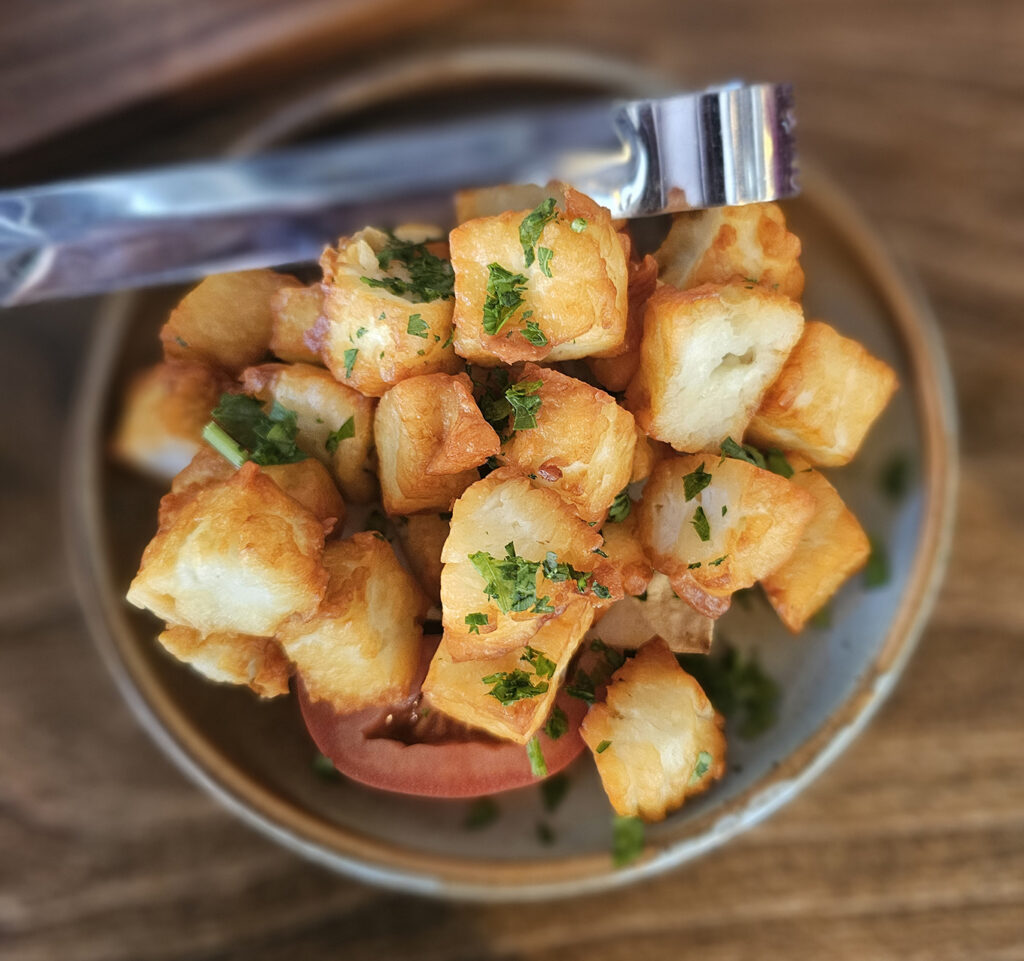
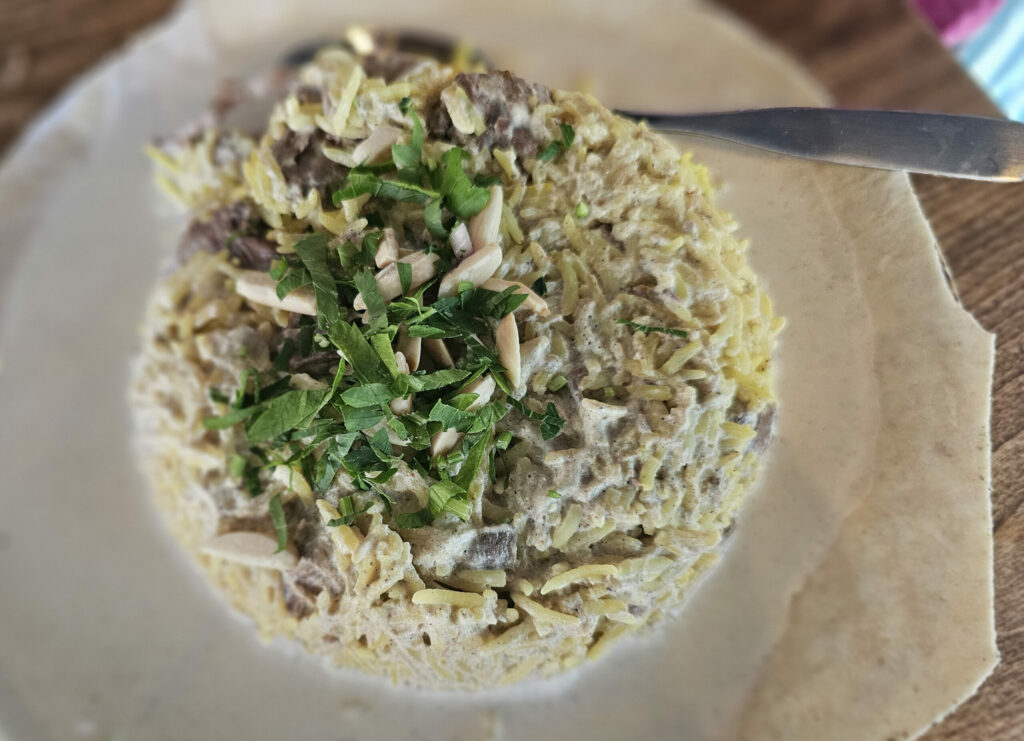
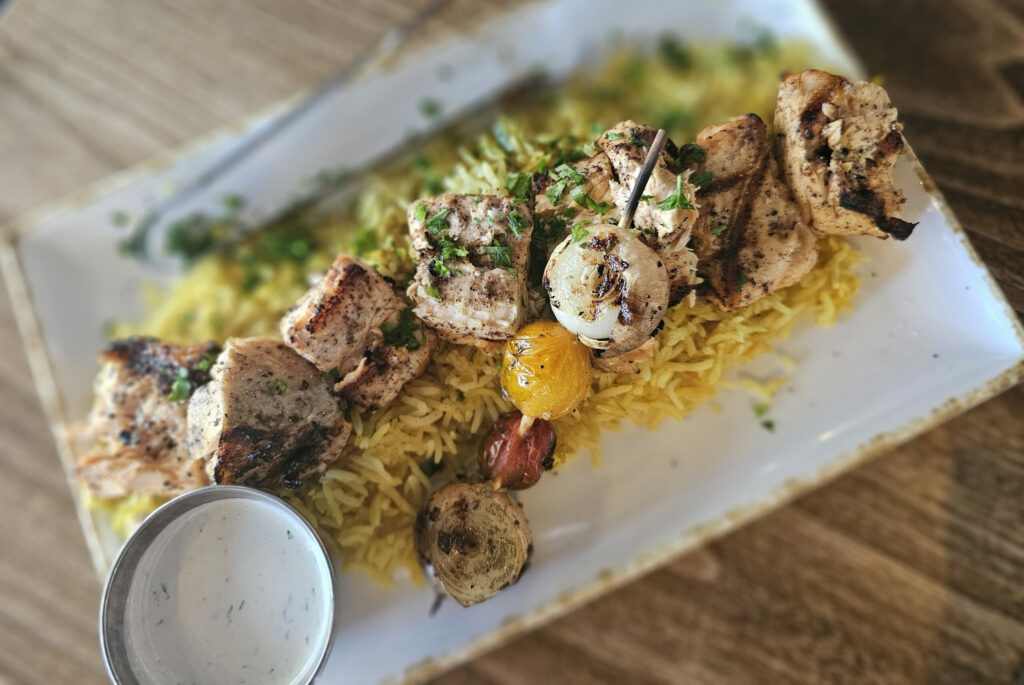
It’s rare for a restaurant opening to sneak up on me, but last week, Levant quietly soft-opened in Petaluma’s Theater District, offering an extensive menu that showcases the flavors of Syria, Lebanon, Jordan and Palestine.
Co-owner Arafat “Art” Herzallah of San Francisco’s popular Freekah restaurant has teamed up with longtime Petaluma residents Saheer Kassis and Issa Musalla to create a Middle Eastern culinary oasis at the site of the former Trattoria Roma.
Many dishes on Levant’s menu are tried-and-true favorites from Freekah, including cold mezze samplers with creamy hummus, yogurt-based labneh, smoky baba ghanoush and muhamarra, a sweet red pepper dip with walnuts ($21-$28). All are served with warm bites of pita bread.
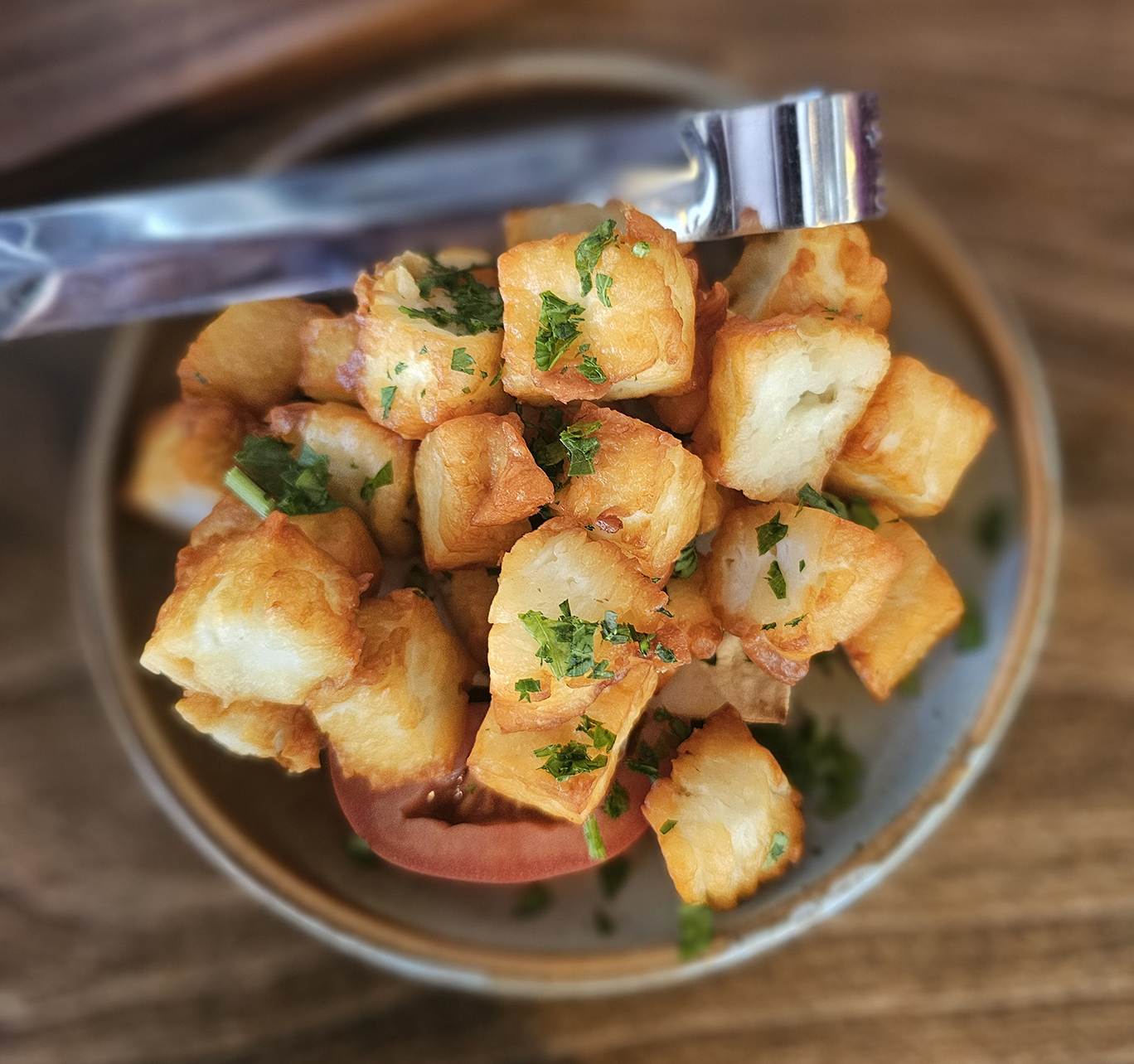
Hot mezze, such as fried halloumi (Jibneh Halloumi, $12), grilled Palestinian cheese (Jibneh Nabulsi, $12), fried cauliflower with tahini sauce (Zahara Bil Tahini, $16) and falafel ($10), also appear on the Freekah menu, along with skewers, wraps and salads.
Unlike the tapas-style dishes at Freekah, Levant dives deeper into the traditional, family-style meals of the Middle East, like Kufta ($24), a ground beef and lamb dish with sliced potatoes, onions and spices, topped with tahini or tomato sauce; and Lahme ($26), lamb simmered with potatoes. Mansaf ($32), a classic Jordanian dish made with lamb, spiced saffron rice and jameed (fermented yogurt), is an intensely flavored option that, while not my cup of tea, offers an earthy tangy richness inspired by Herzallah’s grandmother’s recipe.
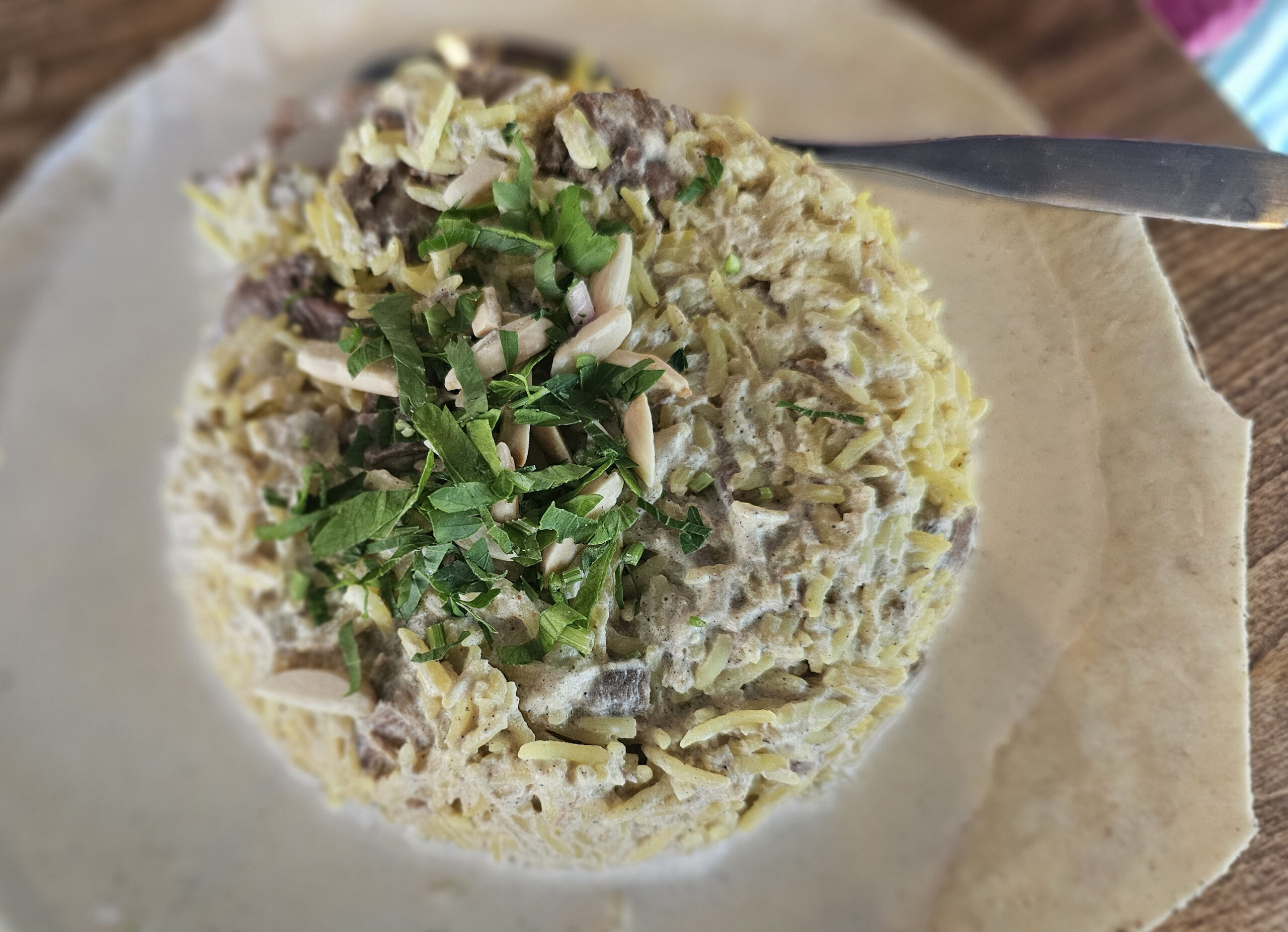
The menu features a handful of Lebanese and Jordanian wines alongside pungent Turkish coffee and delicious mint tea.
First impressions
Levant is warm and inviting, and Herzallah’s wife, Monyca Currier-Herzallah, is an excellent guide, offering detailed explanations (sometimes with family stories) of each dish. As a longtime vegetarian, she has added plant-based meat options to an already vegetarian-friendly menu (which also features many gluten-free options).
The restaurant’s interior remains largely unchanged, with warm wood tones and earthy hues in the compact, 1,700-square-foot space. While the open kitchen can get a bit noisy at times, it also provides a fascinating peek at ingredients and preparations.

Several dishes were a little heavy-handed on the salt, but spiced saffron rice had an intoxicating scent. Plates are meant to be shared, so be sure to go with friends and dip your pita bread with abandon.
There’s no shortage of Middle Eastern cuisine in Sonoma County (thankfully), with more than a dozen options for great hummus, tabbouleh, shawarma and falafel. But Levant stands apart with its traditional family recipes and many personal touches — something far harder to find.
Levant is at 140 Second St., Suite 100, Petaluma, 707-658-8017. Website coming soon. Open 4-9 p.m. Tuesday through Sunday. instagram.com/Levant_Petaluma
You can reach Dining Editor Heather Irwin at heather.irwin@pressdemocrat.com. Follow Heather on Instagram @biteclubeats.
The post Homestyle Middle Eastern Restaurant Levant Opens in Petaluma appeared first on Sonoma Magazine.
]]>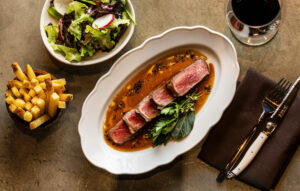
Petaluma's new Bijou — a more casual cousin to Table Culture Provisions’ fine dining experience — is the latest from acclaimed chef Stéphane Saint Louis.
The post Petaluma’s New Bijou Restaurant Is California-Inspired With a French Accent appeared first on Sonoma Magazine.
]]>





Table Culture Provisions’ recent snub by the 2025 California Michelin Guide isn’t keeping chef Stéphane Saint Louis up at night. But his new Petaluma restaurant, Bijou, is a different story.
Since December, Saint Louis has been laser-focused on what he calls his “dream restaurant” — a more casual cousin to Table Culture Provisions’ fine dining experience. Hiring servers, training new kitchen staff and fine-tuning an ever-evolving California-French menu has kept him deep in the weeds, with 18-hour days leading up to Bijou’s June 13 opening.
“I’m not mad about (the Michelin star), because I’m very busy with Bijou. I don’t mind things happening in due time, step by step,” he said while prepping for a Monday night service at the restaurant.
Still, it’s a disappointment.
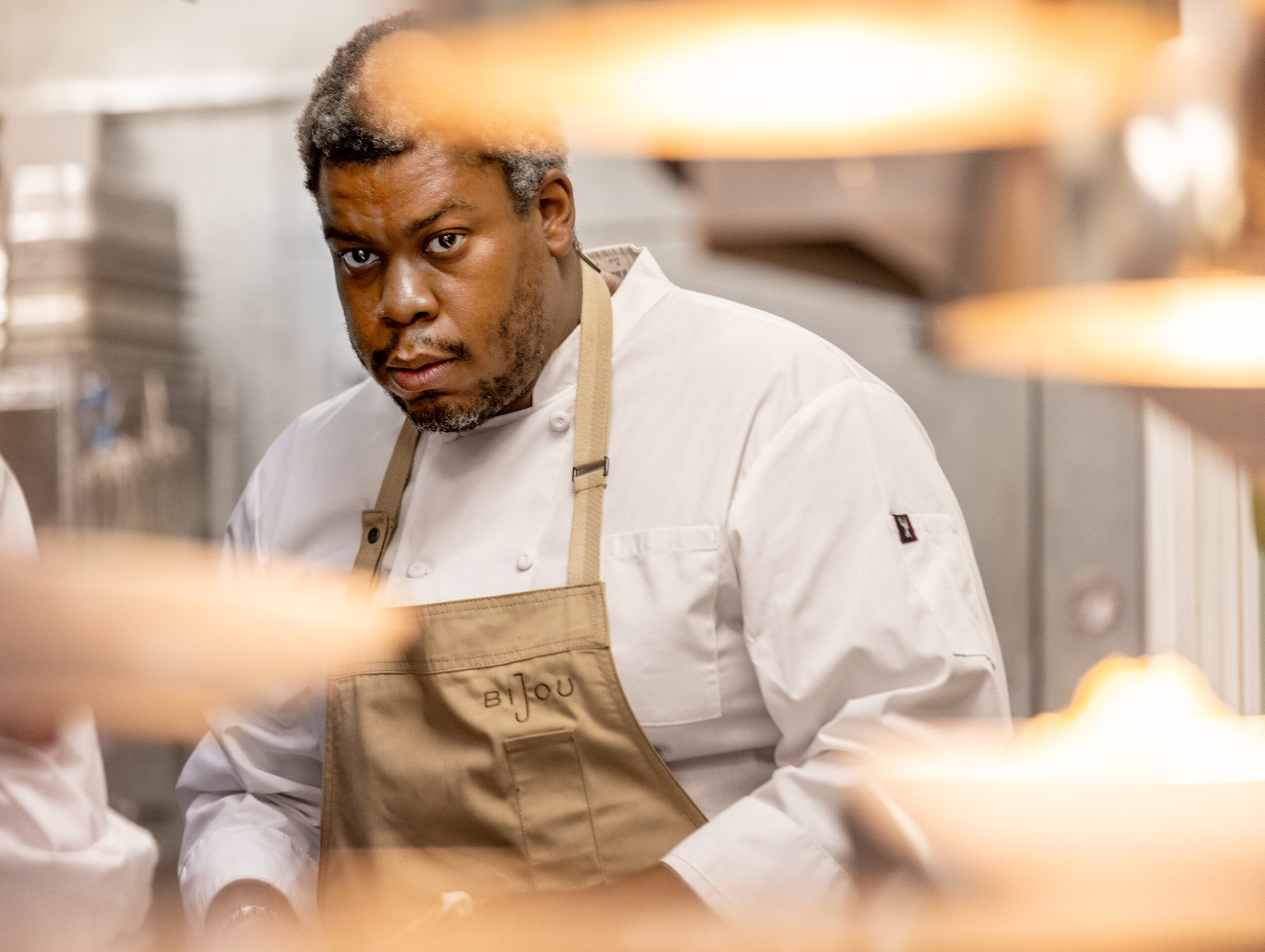
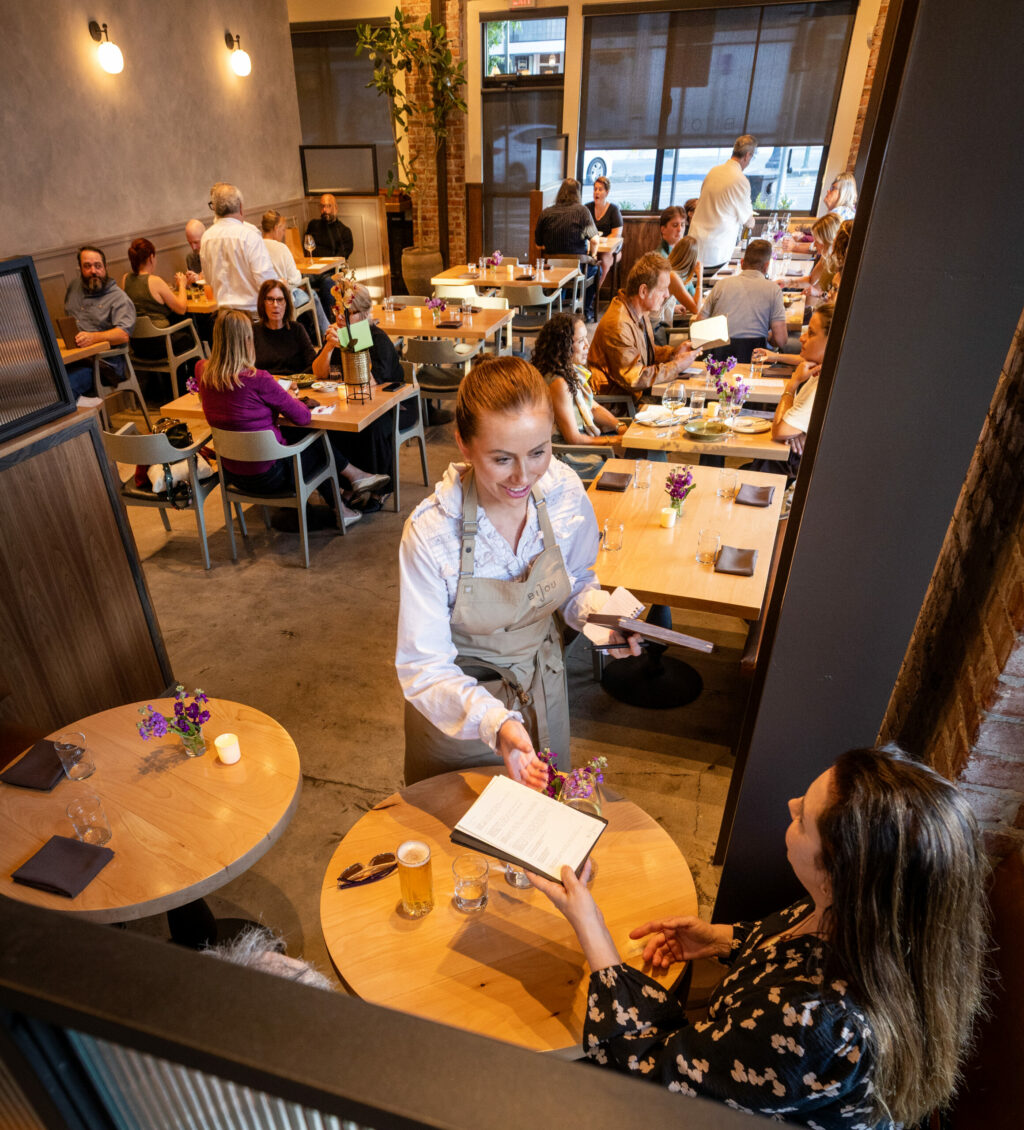
In March, Michelin added Table Culture Provisions (TCP) to its California Guide, calling it “too good to overlook.” The mention doubled business at the 17-seat restaurant overnight, Saint Louis said. On weekends, it’s now booked months in advance.
By all accounts, it seemed likely the four-year-old fine dining restaurant, which Saint Louis co-owns with chef Steven Vargas, would earn a star — potentially making it the first Black-owned Michelin-starred restaurant in California.
But right now, Saint Louis has more than enough on his plate without the pressure and heightened expectations that tend to come with the culinary award.
“If we get a star, I’ll never take it for granted,” he said. “But right now, I have to do what I do best and win people’s hearts with food.”
Building Bijou
“I’ve never had the luxury of building the perfect restaurant,” Saint Louis said.
From its prime downtown location to its constantly evolving menu, Bijou reflects his personal vision. As a young chef working across the street at The Shuckery, Saint Louis often eyed the expansive modern space, imagining that it would one day be his.
“I would look at this building and I’d think, ‘Man, one day, I think I’m going to get this place,'” he recalled.
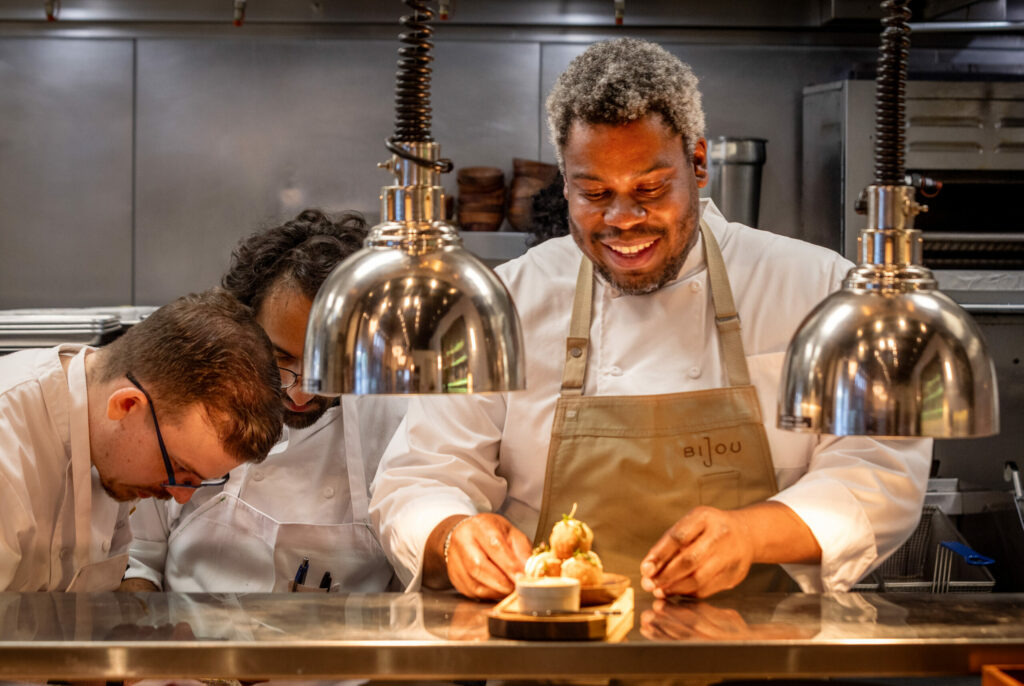
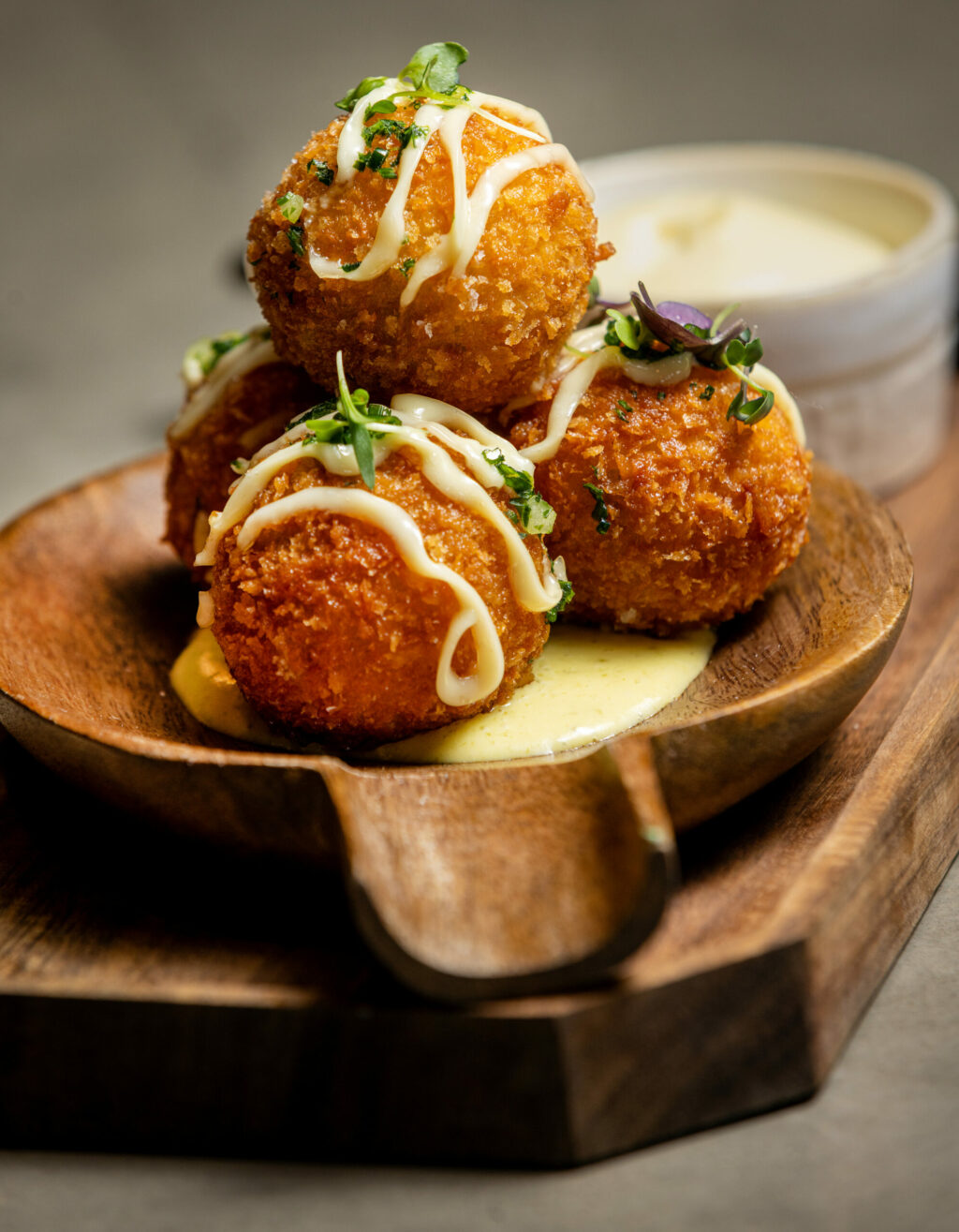
When Easy Rider closed in December 2024, he jumped at the opportunity. The space came with a full bar and a well-equipped, upgraded kitchen.
Bijou, which means “jewel” in French, gives Saint Louis room to play. Its à la carte menu offers a broader canvas for his creativity.
“I wake up with so many ideas. Every day I take an item off the menu and put something new in. I love having so much creative freedom,” he said.
The food
Consider this more of a first look than a formal review. The menu has already changed significantly from my first visit, so much so that Saint Louis expressed concern when I asked about the plating and preparation of some of the dishes I tried.
“What I made last week and what’s going to come out today is going to be so different,” he said.
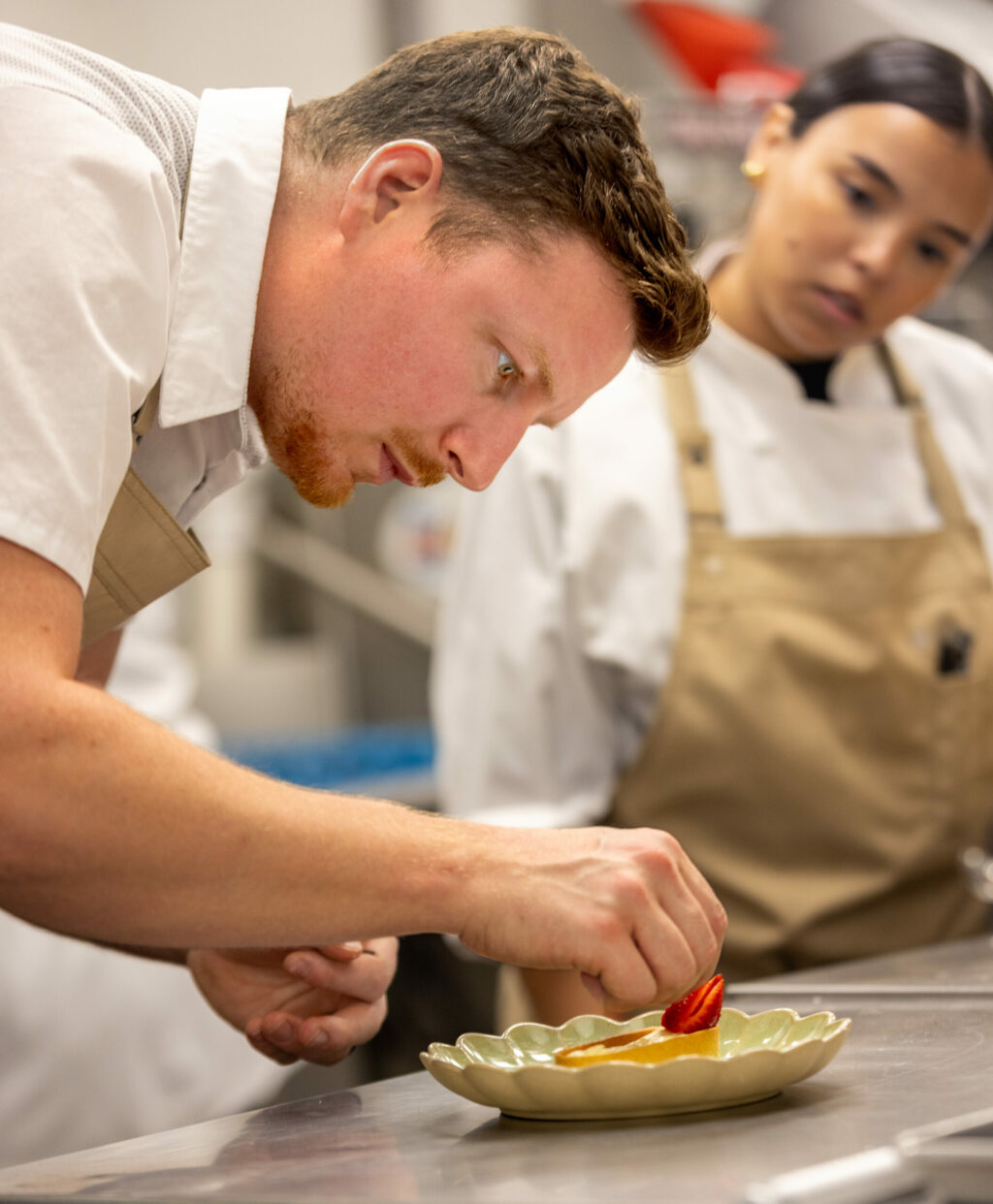
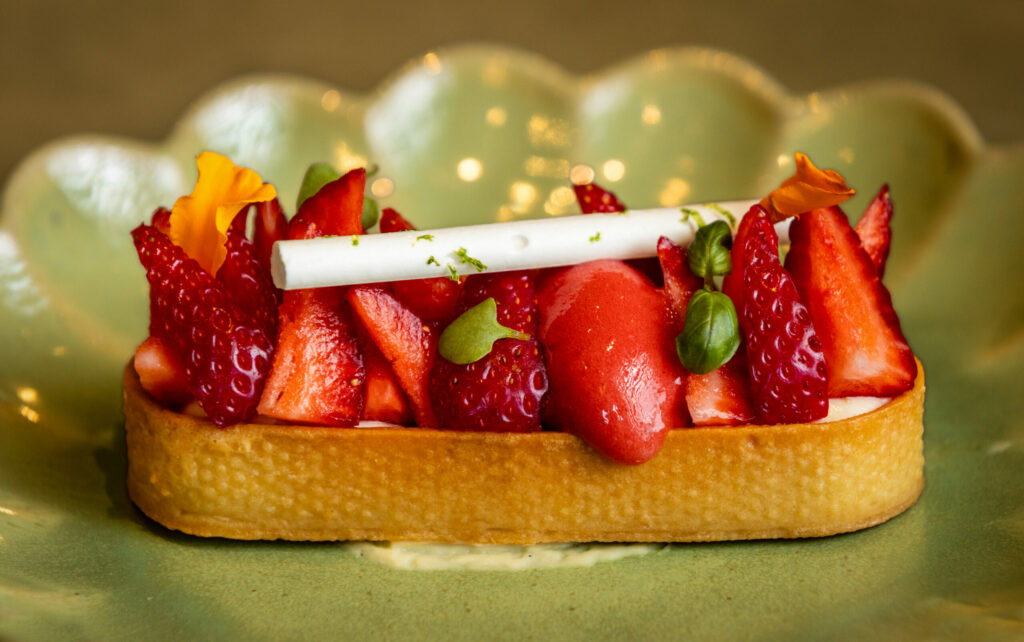
Some staples, however, will remain on the menu — a fish entrée, steak frites, housemade pasta and several starters. While the components may change, the palate remains rooted in Saint Louis’ culinary training.
“I’m a French-trained chef, but this isn’t the usual bistro-type of food. It’s all about the technicality in the kitchen,” he said.
That translates to elegant sauces, meticulously sourced ingredients and refined plating — all at midrange prices. Entrées range from $26 to $42, with snacks and shareables between $18 and $22.
On my visit, the daily catch was white sea bass with charred, crispy skin, served atop melted leeks and finished with a yin-yang of buttery leek sauce and rich steak jus ($32). It was light yet decadent, and perfectly executed.
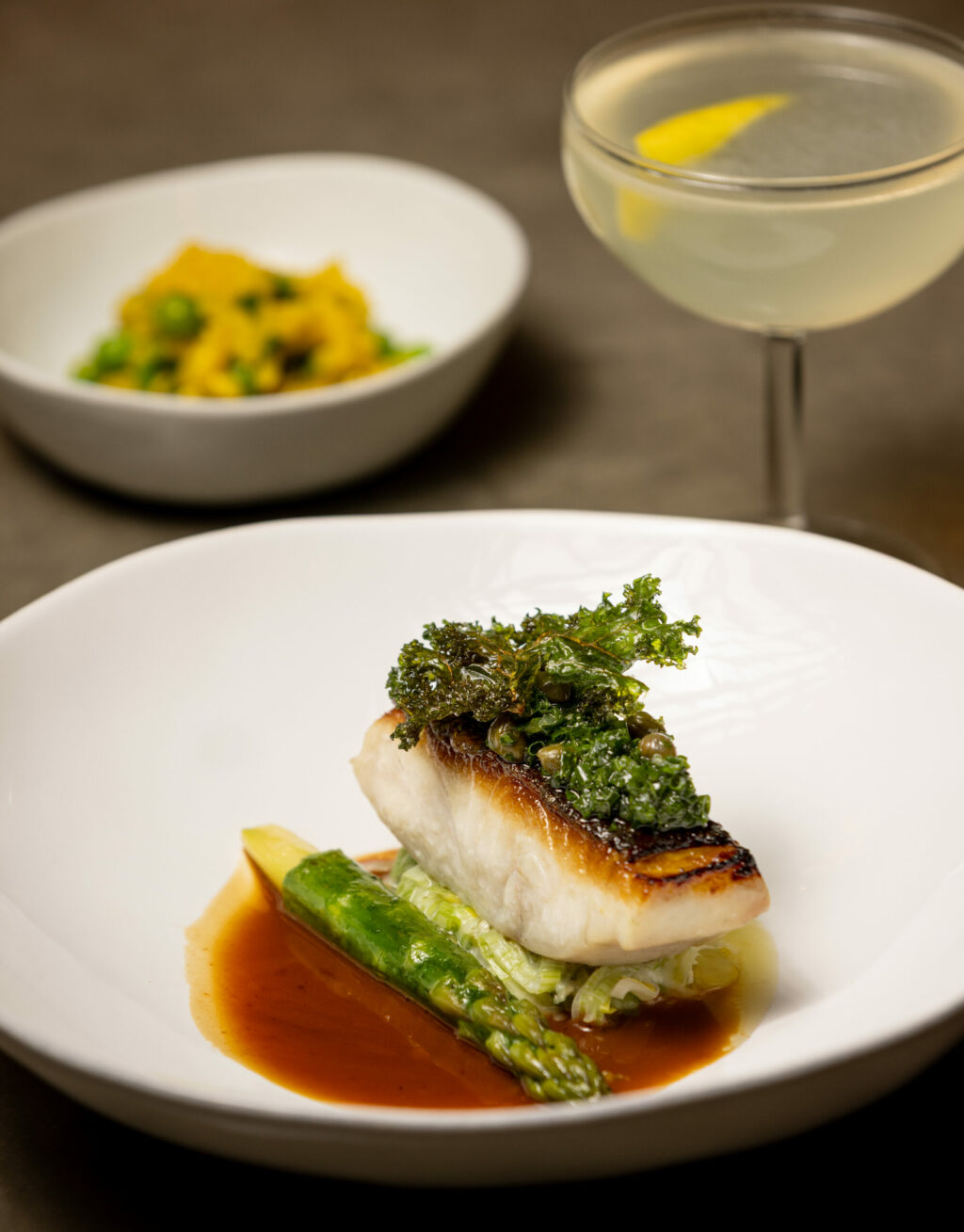
Bijou’s steak frites ($42) restored my faith in this bistro classic after too many run-ins with gristly, undercooked hanger steaks and gloopy Bordelaise sauces elsewhere. Here, generous slices of tender steak come with a rich peppercorn sauce and fries on the side, to keep them crisp and ready for dipping.
The well-curated menu also includes dishes like duck caramelle pasta (candy-shaped pasta stuffed with duck), diver scallops with tobiko, and TCP’s now-legendary Parker House Rolls ($12). These warm, yeasty rolls are as fluffy as cotton candy and finished with flakes of sea salt — a must-order.
While not every dish hit the mark in the weeks after opening, Saint Louis is constantly refining the menu to meet his exacting standards.
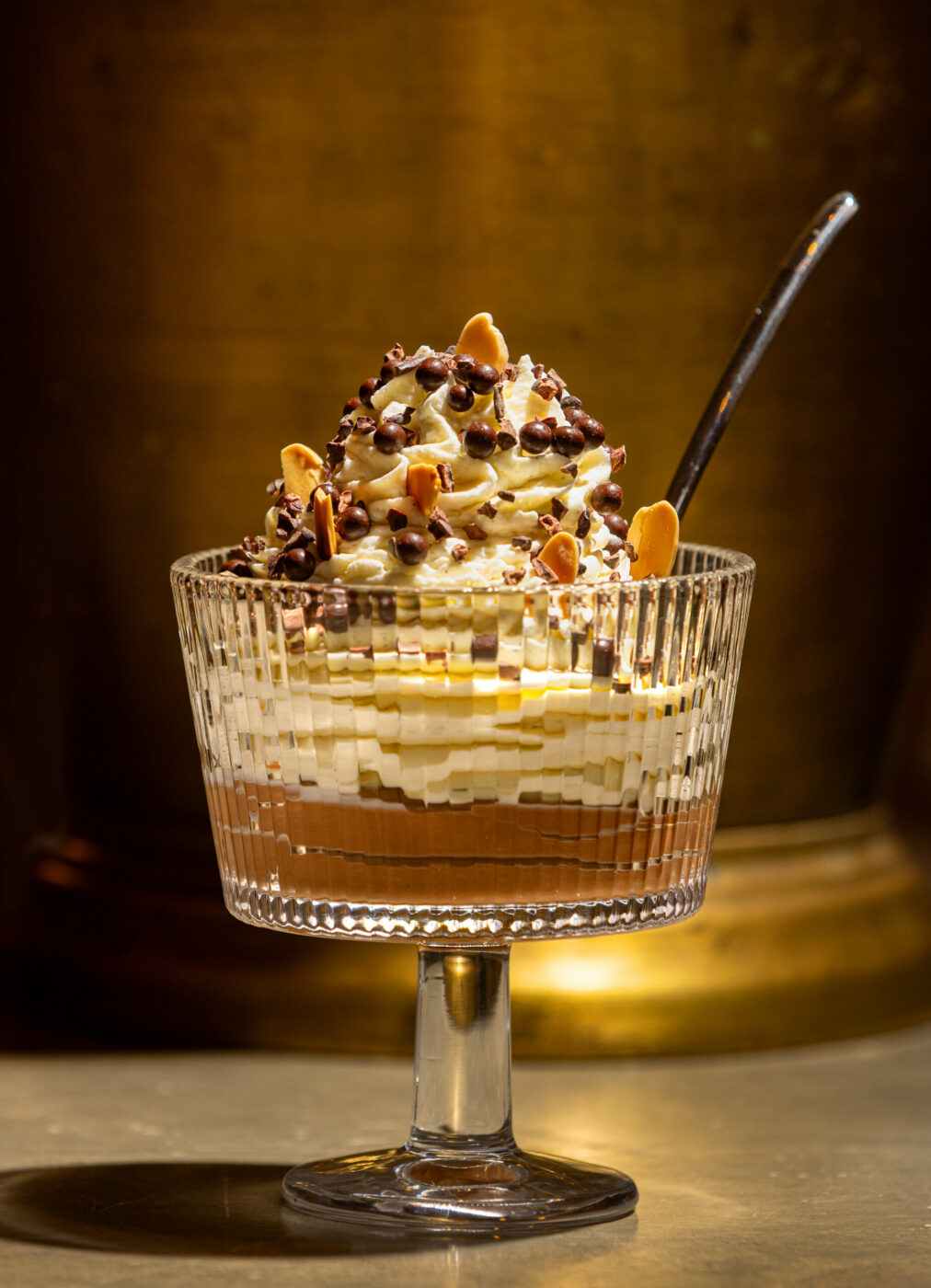
“I’m still trying to find myself here,” he said. “Right now, I’m at the stage where I’m getting the machine going with my personal ideas and goals, what I want service to look like and the dishes to be.”
With any luck, Michelin will take notice in 2026.
Bijou, 190 Kentucky St., Petaluma. Reservations are available on OpenTable and are highly recommended. Open 4-9 p.m. Thursday through Tuesday, closed Wednesdays. Note: The restaurant automatically adds a 5% service charge for staff.
You can reach Dining Editor Heather Irwin at heather.irwin@pressdemocrat.com. Follow Heather on Instagram @biteclubeats.
The post Petaluma’s New Bijou Restaurant Is California-Inspired With a French Accent appeared first on Sonoma Magazine.
]]>
After making his mark on the Sonoma County dining scene, chef Stéphane Saint Louis of Table Culture Provisions is gearing up for his second Petaluma eatery, Bijou.
The post Chef Stéphane Saint Louis’s Dining Journey Comes Full Circle With Upcoming Petaluma Restaurant appeared first on Sonoma Magazine.
]]>





Stéphane Saint Louis has already made his mark on the Sonoma County dining scene, from cheffing at Petaluma favorite Della Fattoria and The Shuckery to launching his first restaurant, the recently Michelin-recommended Table Culture Provisions.
But with two young boys in tow, Saint Louis and his wife and business partner Marta Saint Louis are just getting started. Together with co-owner Steven Vargas, who also worked at Della, they open their second Petaluma eatery, Bijou, this month.
Saint Louis promises “bistronomy,” a blend of French cooking technique and Sonoma County seasonal farm-to-table. Bijou’s opening will draw attention for more than just its menu or its pedigree. The restaurant occupies a prime downtown location previously housing Whisper Sisters and then Easy Rider. With Saint Louis moving in, the corner — and Petaluma’s culinary reputation — appear to be in good hands.

Petaluma Roots
I’ve always felt welcome here. When I worked for Kathleen [Weber] at Della, she would introduce me to all of these local purveyors, whether it was the owners of Cowgirl Creamery, or Straus, or Liberty Duck. Even as a sous chef, I had already developed these farmer-to-chef relationships. I continued on, and built a name for myself, a reputation in the community. And Petaluma always felt like home to me.
Full-Circle Moment
I used to come here all the time. I used to hold my kitchen team meetings in this space. During Covid, I would leave The Shuckery, and I would look at this building right across the street, and I’d think, “Man, one day, I think I’m going to get this place.” Six months ago, when I saw the ad come up [for Easy Rider], I didn’t even think twice. I called the broker and I said, “I want it. Take the ad down.”
A Family Affair
We live next to TCP, so my oldest will jump the fence and come to the restaurant and say, “Daddy, can I get some fries,” or “Can I get some steak,” “Can I get some scallops?” My youngest, every time he comes in, he tastes every single sauce I have going, and he gets so excited about it. Marta is taking care of the kids and running the business. And then we can go to the farm, and the boys can play outside and harvest strawberries, or whatever it is. It’s a lifestyle.
Facing the Unknown
Bijou is much more casual, faster-paced, higher-volume. It’s going to be a whole different ballgame. We’re going to have a lot more staff, more variety of guests coming in, a more affordable price point. I am just looking forward to the challenge, and I’m not afraid of it. Whatever challenges that are going to come with this, I’m ready to face them. I live for this.
The post Chef Stéphane Saint Louis’s Dining Journey Comes Full Circle With Upcoming Petaluma Restaurant appeared first on Sonoma Magazine.
]]>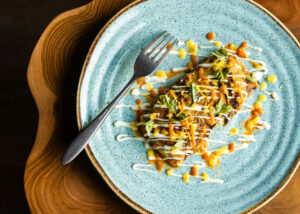
Wood-fired pizza, hanging laundry and mortadella on a trapeze capture the chaos and creativity of Southern Italy’s largest city.
The post Theatrics Don’t Take Away From the Food at Petaluma’s New L’Oro Di Napoli appeared first on Sonoma Magazine.
]]>





It’s hard to know whether I’m delighted or horrified by the baseball bat-sized pepper grinder headed toward my table. Death by Spice would be such an embarrassing obituary. But as our server approaches with this cannon of seasoning, I also notice slices of mortadella flapping on a tiny trapeze headed toward a neighboring table from the corner of my eye.
I’m in a bad Fellini movie, or Petaluma’s newest Italian hot spot, L’Oro di Napoli, is as much theater as it is a restaurant.
Located in downtown Petaluma’s historic commercial district, the 8,000-square-foot building at 208 Petaluma Blvd. North is a worthy backdrop. Built in 1870, the exposed brick walls, soaring ceilings and sky-high windows set the stage for a tableau of Neapolitan life, complete with shuttered “windows” overlooking the dining room and bar, and a faux balcony above the dining room similar to the Santa Rosa restaurant. Cheeky laundry lines full of clothes — like the ones decorating the Fourth Street restaurant — will be installed soon.
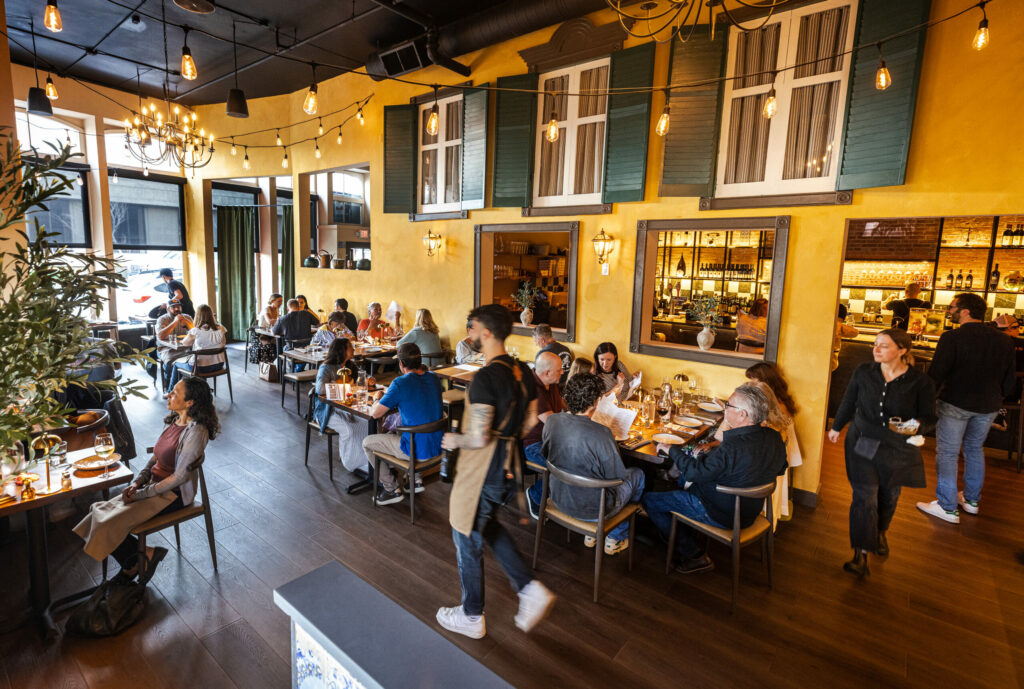
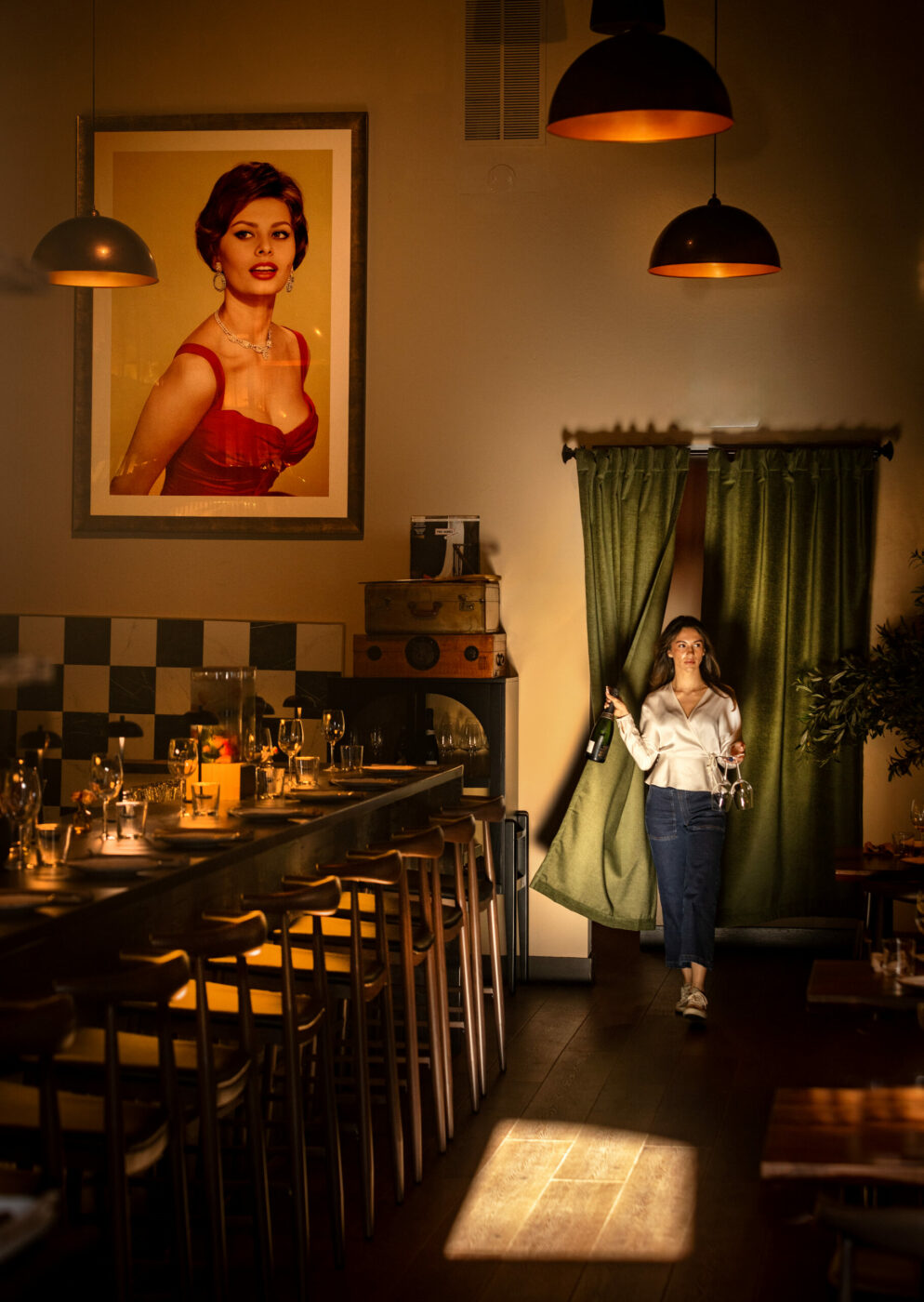
“We want you to feel like you’re in Italy when you’re here,” said co-owner Domenico De Angelis in thickly accented English. A native of Naples, he’s imported not only the feel of his hometown but authentic Italian ingredients and a Southern Italian staff mostly made of friends from home. When you’re at De Angelis’ restaurant, which he owns with Roberto Sbaraglia, you’re truly part of a family.
That includes plenty of intentional cacophony that the owners say is part of the fun. When I asked about the rising decibel level as the night progressed — Americans tend to be sensitive about that kind of thing — the answer was that Naples can be loud and chaotic, and they wanted to recreate that atmosphere.
An expanded space, expanded menu
More than double the size of the flagship Neapolitan-style pizzeria and trattoria in Santa Rosa, the second outpost of L’Oro di Napoli opened in early March at the former Thai Issan.
Santa Rosans have been flocking to the original L’Oro di Napoli on Fourth Street since it opened in 2022. The thin-bottom, leopard-spotted Neapolitan-style pizzas are the real deal, using imported ingredients and De Angelis’ pizzaiolo skills. The six-layer lasagna is stuffed with beef Bolognese, béchamel, tomato sauce and Parmesan cheese. It’s the best nonna-style lasagna you’ll ever eat.
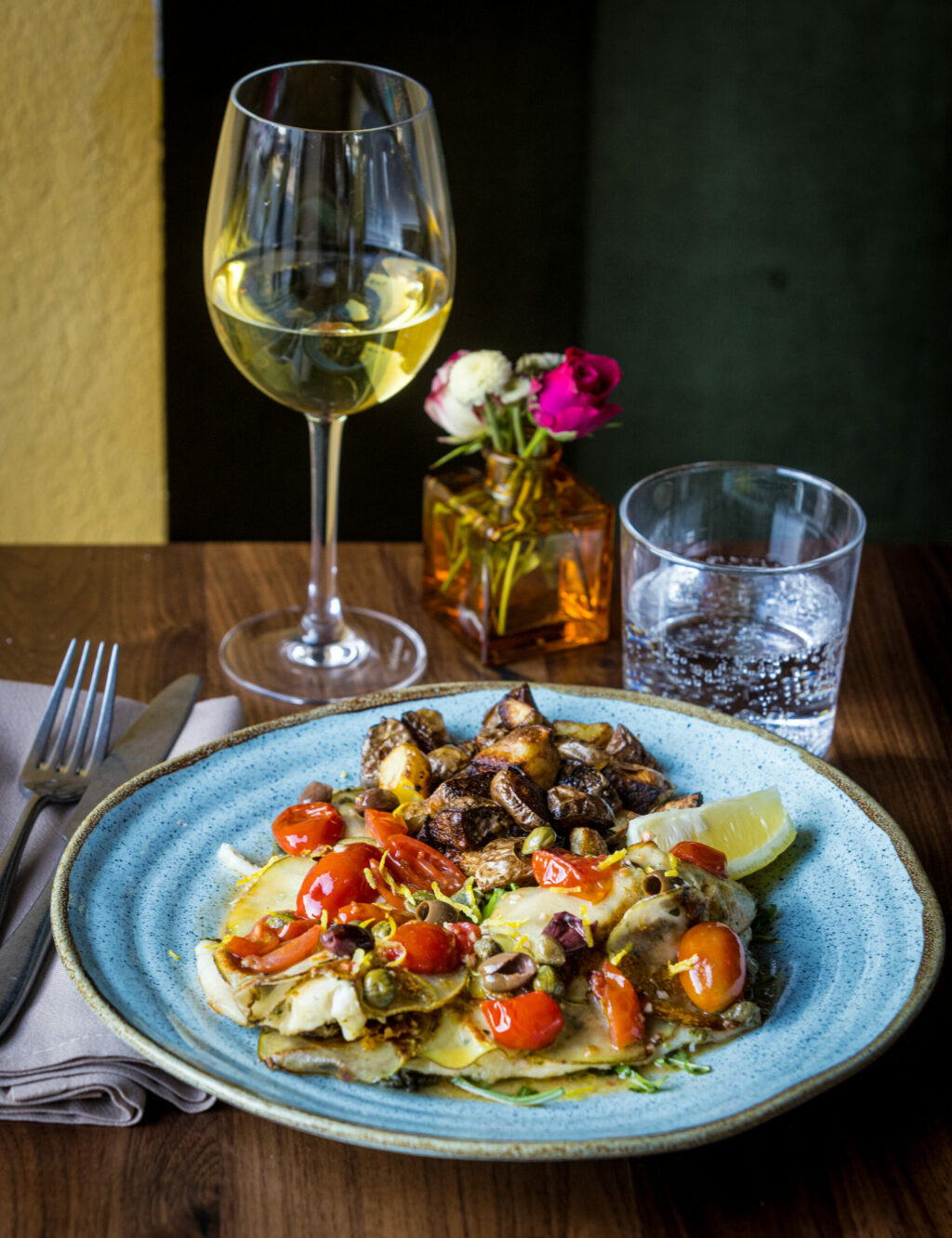
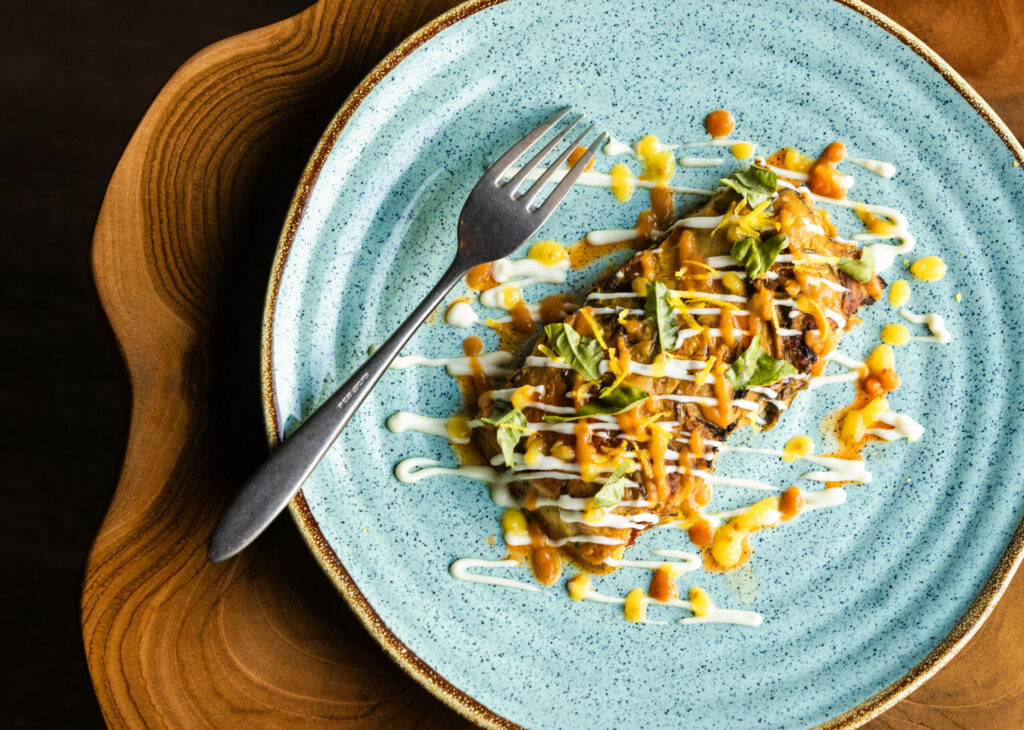
In Petaluma, not only is the space larger, but so is the menu. Offerings include a long list of antipasti, such as fried calamari, Brussels sprouts with pecorino, salads and most importantly, fresh pasta, plus new entrées like zucchini Parmesan and branzino with a lemon-wine sauce. The one thing you won’t find is the legendary lasagna — De Angelis wants to keep that a Santa Rosa specialty.
Despite the many little surprise and delightful moments at L’Oro di Napoli, the food never takes a back seat. De Angelis and his crew know how to make the comforting, approachable Southern Italian cuisine of their ancestors. The Pompeii-style wood-fired oven, imported from Naples, would be recognizable to ancestors from millennia past, cooking the same style of bread and round dough unearthed by archaeologists.
L’Oro di Napoli is a joy to experience, from the moment you walk in the doors to your last bite of tiramisu. Enjoy the show.
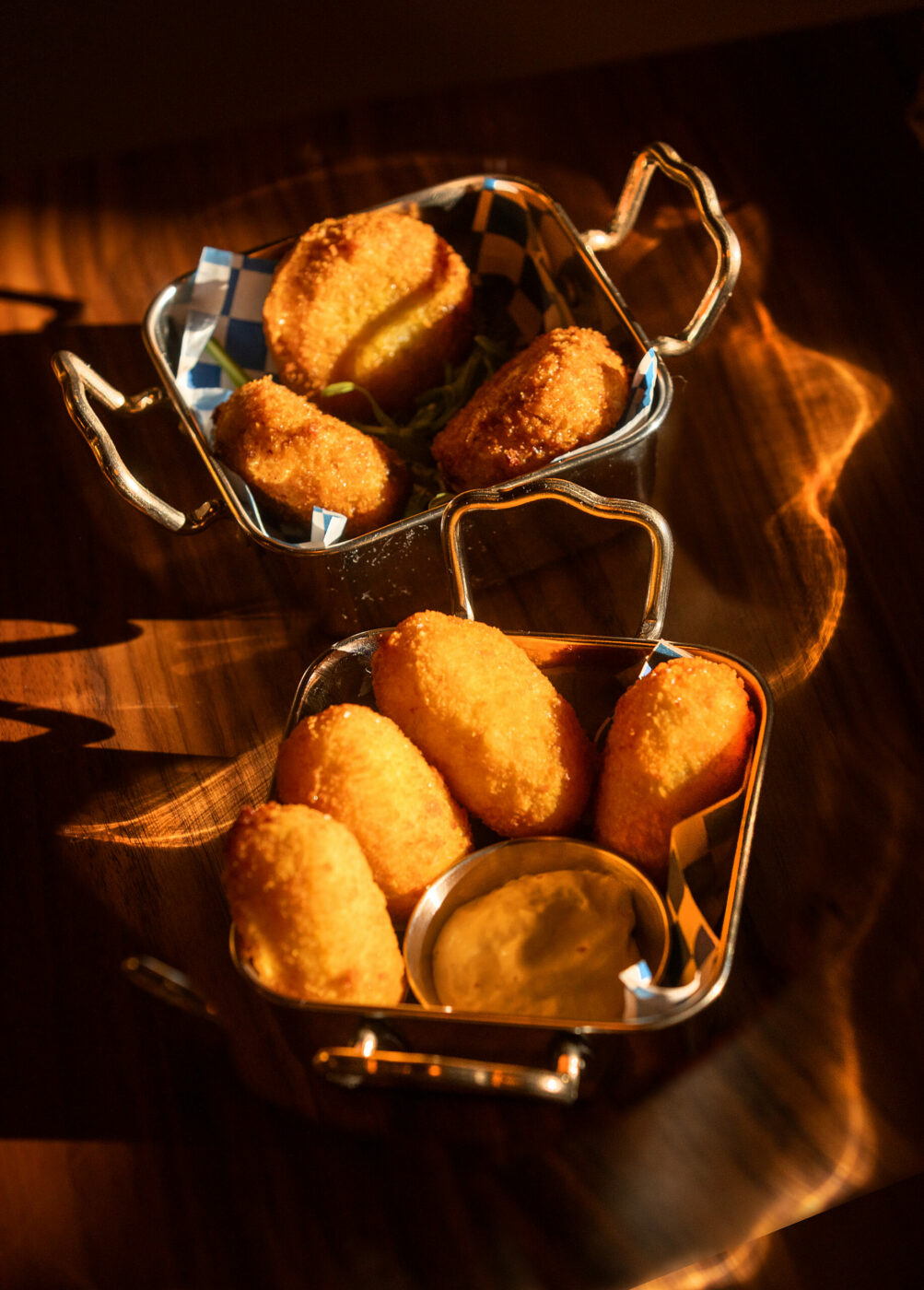
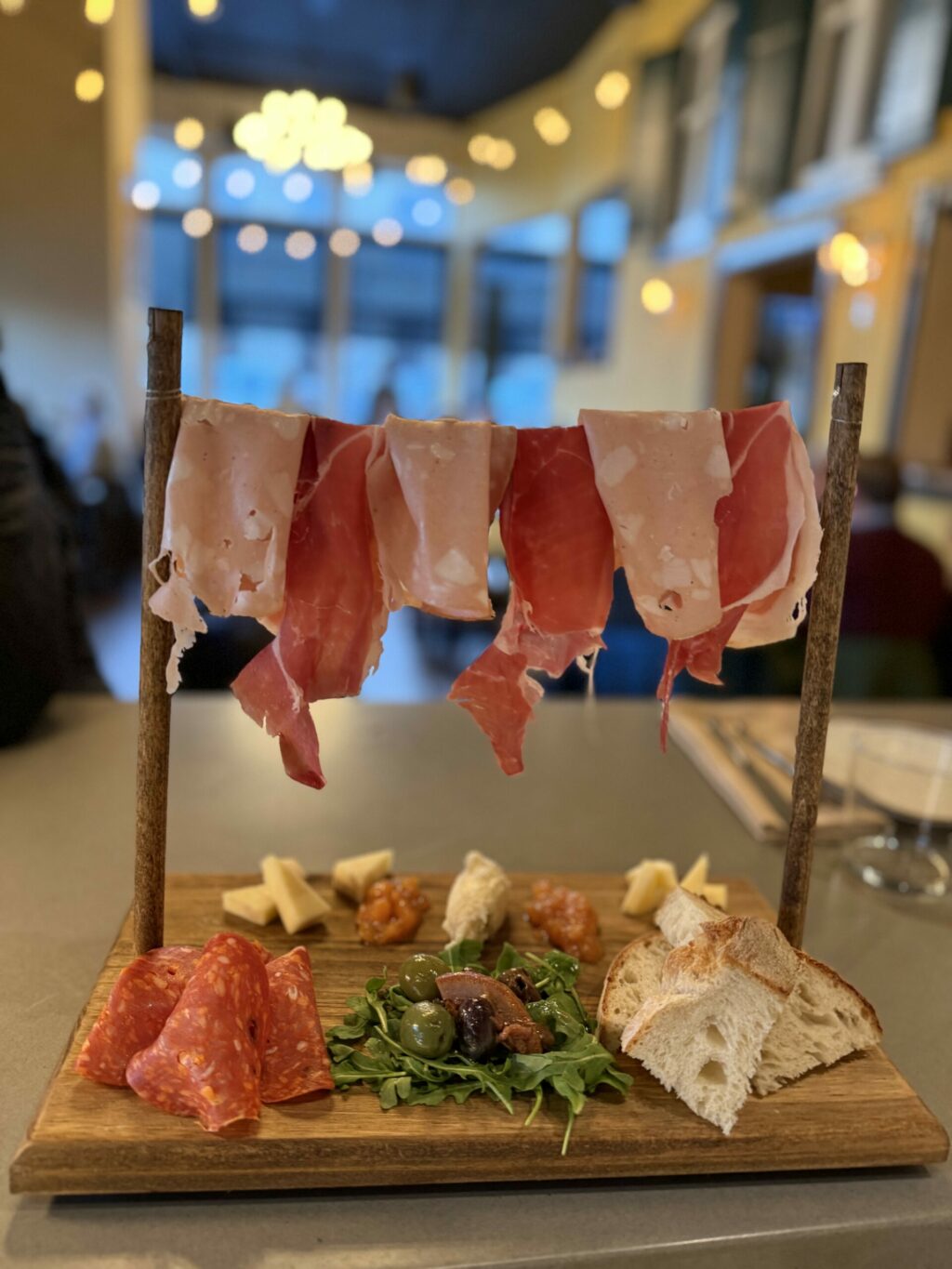
Best Bets
Charcuterie board, $27: You’ve never seen a meat and cheese board like this. Slices of mortadella hang like trapeze artists on a line stretched between two dowels with cheese wedges below, offering a safety net if anything falls. You have to appreciate the sheer silliness of it all. Though slightly over-the-top, when was the last time your food did a circus act?
Frittatina, $16: Think mozzarella stick meets arancini ball. Bucatini pasta with béchamel sauce, peas and Bolognese ragu is rolled into a patty, breaded and fried — a perfect bar snack with a Hugo spritz cocktail.
Homemade bread, $5: Fresh, crusty bread served with chimichurri and balsamic butter. It’s wonderful, but keep a couple of slices to sop up sauce.
Caprese con burrata, $15: A fist-sized ball of soft mozzarella stuffed with cream is never a bad choice. This version doesn’t need much gussying up, served with San Marzano tomatoes, fresh basil and balsamic. You’ll be spoiled for any other version.
Pappardelle al tartufo, $28: Black truffle cream sauce, sausage and mushrooms cling to wide strips of fresh pasta that are both silky and toothy.
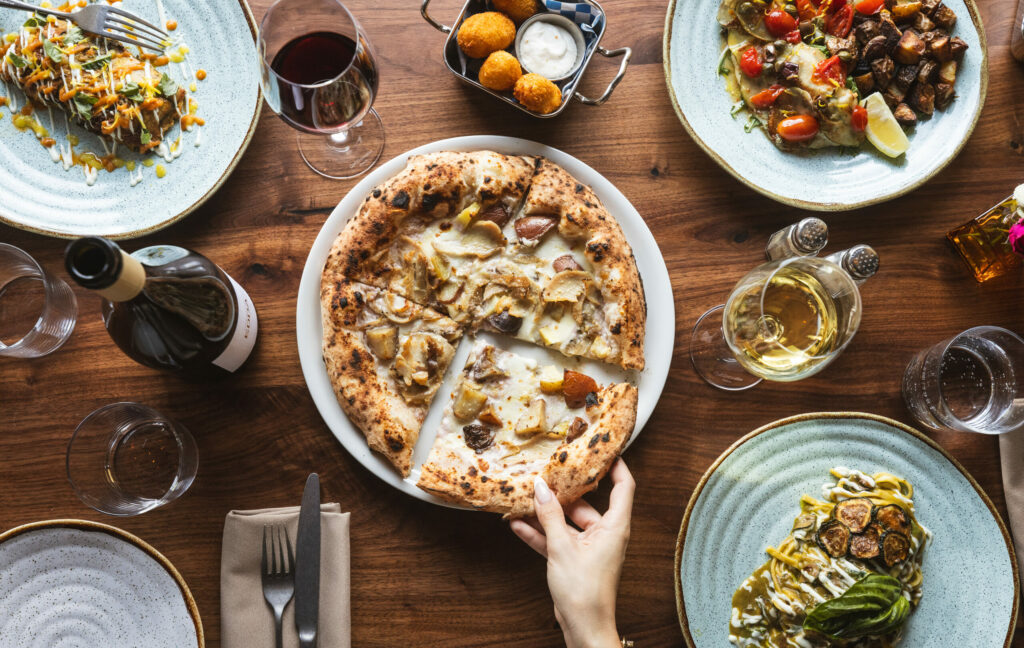
Pistachio pizza, $25: Neapolitan-style wood-fired pizzas are the soul of L’Oro di Napoli. You can’t go wrong with any variation, from simple Margherita to the elaborate patate e porchetta with roasted pork and potatoes, plus smoked and pecorino cheese. I fell in love with the pistachio pizza, topped with smoked cheese, pistachio pesto, mortadella, provolone cream and basil. I shared a nearly identical pizza with friends in Split, Croatia, on one of the happiest days of my life — so I may be a little biased.
Tiramisu, $12: This classic Italian dessert made with lady fingers, mascarpone, chocolate and espresso liqueur isn’t the best version I’ve ever had, but it’s undoubtedly the most entertaining. Served in a moka pot — the iconic octagonal espresso maker on every Italian stove — it’s a delightful surprise for the end of a meal.
L’Oro di Napoli is at 208 Petaluma Blvd. North, Petaluma, 707-981-7175, lorodinapolica.com. Open from 4:30 to 9 p.m. Monday, Wednesday and Thursday; noon to 2:30 p.m. and 4:30 to 10 p.m. Friday and Saturday; and noon to 8 p.m. Sunday. Closed Tuesdays.
You can reach Dining Editor Heather Irwin at heather.irwin@pressdemocrat.com. Follow Heather on Instagram @biteclubeats.
The post Theatrics Don’t Take Away From the Food at Petaluma’s New L’Oro Di Napoli appeared first on Sonoma Magazine.
]]>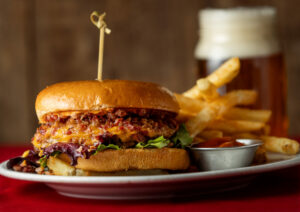
Speakeasy’s after-hours comfort food eats include tacos, burgers, fried chicken and braised short ribs.
The post Speakeasy Serves Late Night Comfort Food in Petaluma appeared first on Sonoma Magazine.
]]>





I hadn’t thought about Petaluma’s Speakeasy restaurant and its sibling music venue, The Big Easy, in a decade — until I started working on a story about Sonoma County’s best mac and cheese. Searching for candidates, Speakeasy’s lobster mac rose to the forefront of a neck-and-neck selection of gooey, melty, cheesy pasta from some of the most recognized restaurants from Cloverdale to Petaluma.
It made the cut based on my memory of the sweet lobster with cheddar, fontina, herby breadcrumbs and crumbled bacon clinging to every surface of the curved orecchiette pasta. But it also made me realize it might be time to see if Speakeasy was still as good as I remembered in its tucked-away location on Kentucky Street.
On a chilly January evening, Speakeasy’s outdoor patio didn’t feel like a good idea despite being a massive draw in warmer seasons. Inside is dark and sparsely decorated with just a few tables and a bar. Service is friendly and adept but not fawning. As early bird eaters, our only company inside was a lone diner at the bar, but tables filled up as night fell in earnest.
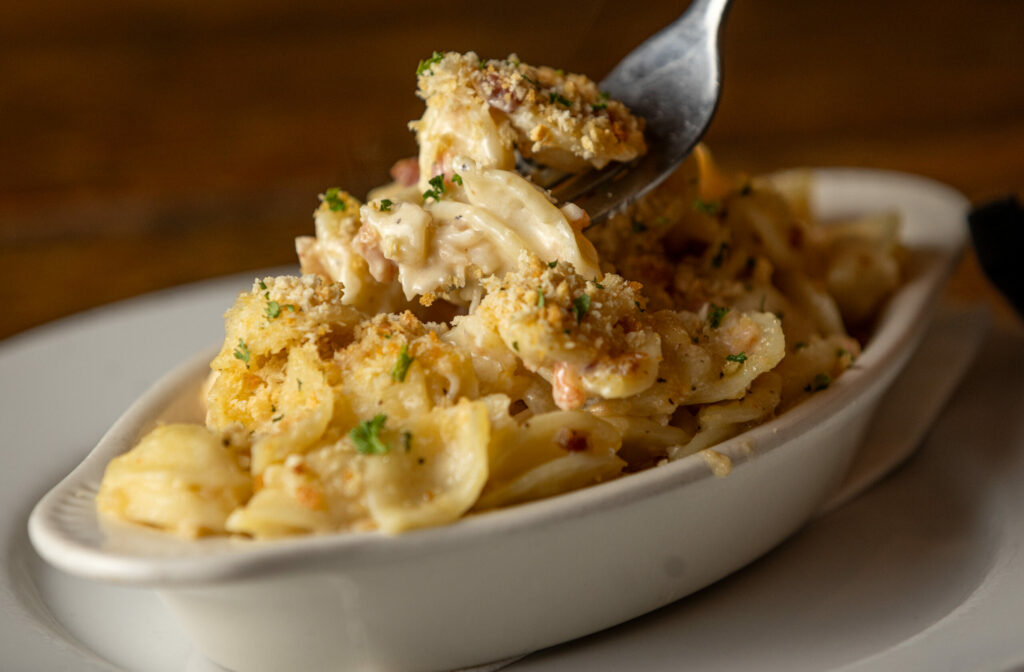
And that’s the point of Speakeasy, one of Petaluma’s few late-night dining options — open until 10 p.m. on weeknights and midnight on Friday and Saturday. It’s the comfort food you crave after a few cocktails: rib-sticking and classic.
You can get the Speakeasy menu with a martini at the neighboring Big Easy while listening to singer-songwriters, jazz, big band, hip-hop and electro-pop seven nights per week. Local music producer Roger Tschann owns both venues.
But this story is about the Speakeasy experience and the food crafted by chefs Jesus Ortiz and Angel Chan. It’s not overwrought cuisine but straightforward comfort food that’s impressive for being just that. Comforting.
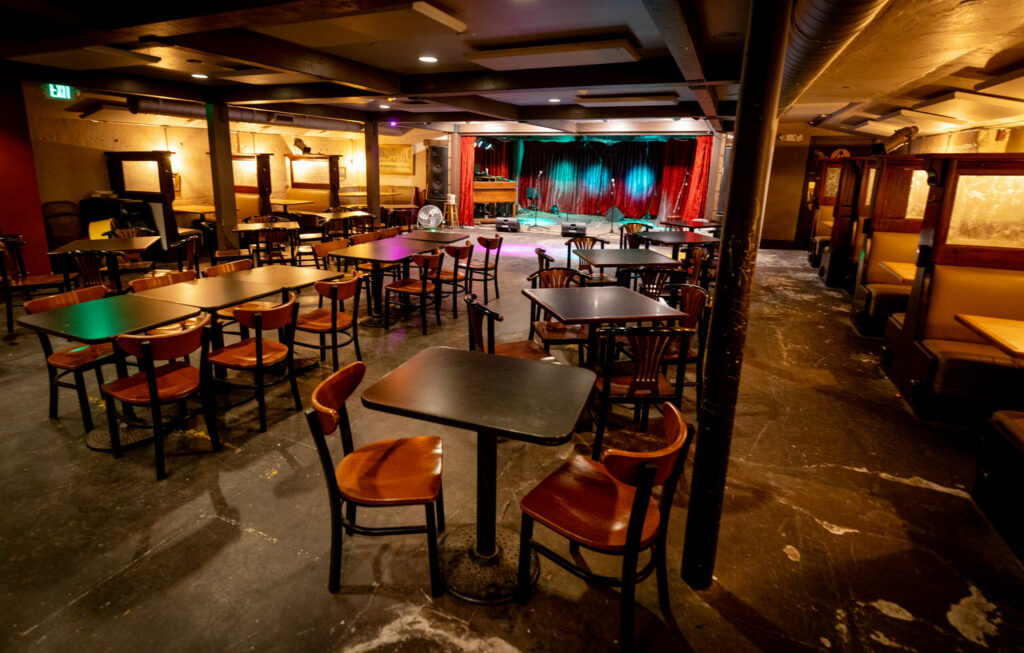
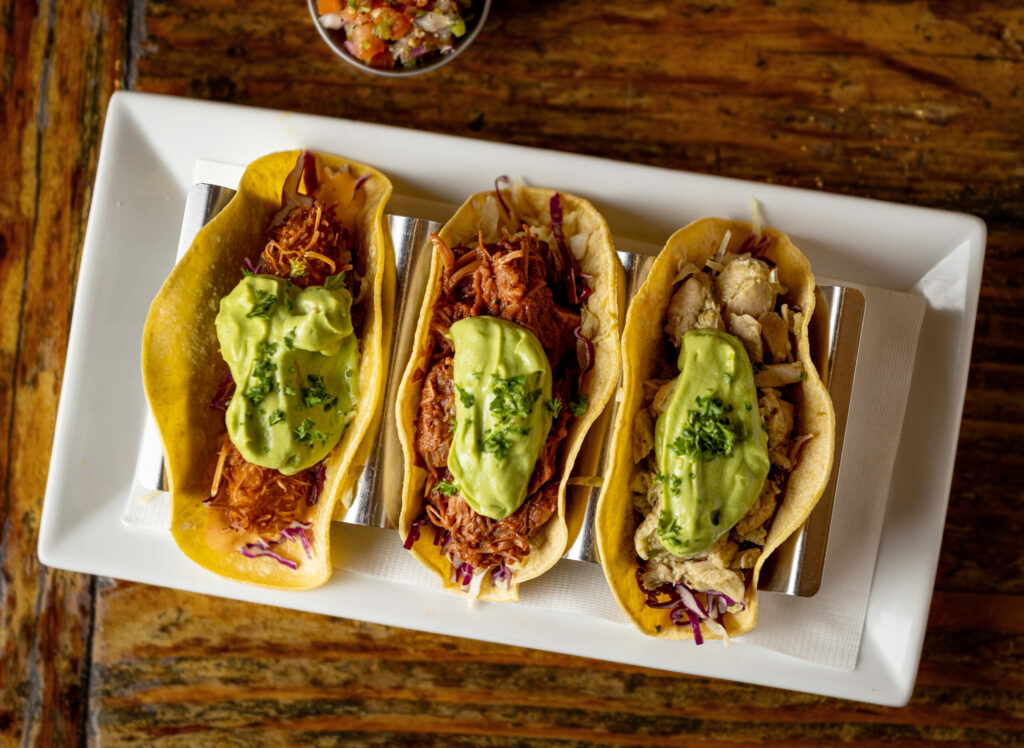
Ortiz is a humble, behind-the-scenes cook you could find in almost any restaurant in Sonoma County. Originally from Mexico, he’s lived in Petaluma for nearly 25 years, working at Old Chicago Pizza and Brixx before joining Speakeasy seven years ago. His cooking skills weren’t bought, but hard-earned while working menial prep jobs and slowly moving his way up the line.
Ortiz isn’t out to win critical acclaim with fancy ingredients, an unstained chef coat and a publicity team. Instead, he works day after day in his well-worn whites, serving good food that makes people happy.
Ortiz and Chan, who is from the Yucatán, have introduced some traditional Mexican dishes, including carnitas, ceviche and tacos, but dishes like the very American mac and cheese, short ribs with polenta, burgers, sandwiches and grilled steak remain their most popular. Prices are incredibly reasonable, and such a relief with the ongoing sticker shock of $32 burgers and $25 salads.
The menu doesn’t change much, though specials appear from time to time, which is just fine. Occasionally, a big bowl of mac and cheese at a restaurant where nobody knows your name is the most satisfying meal of all.
Best bets
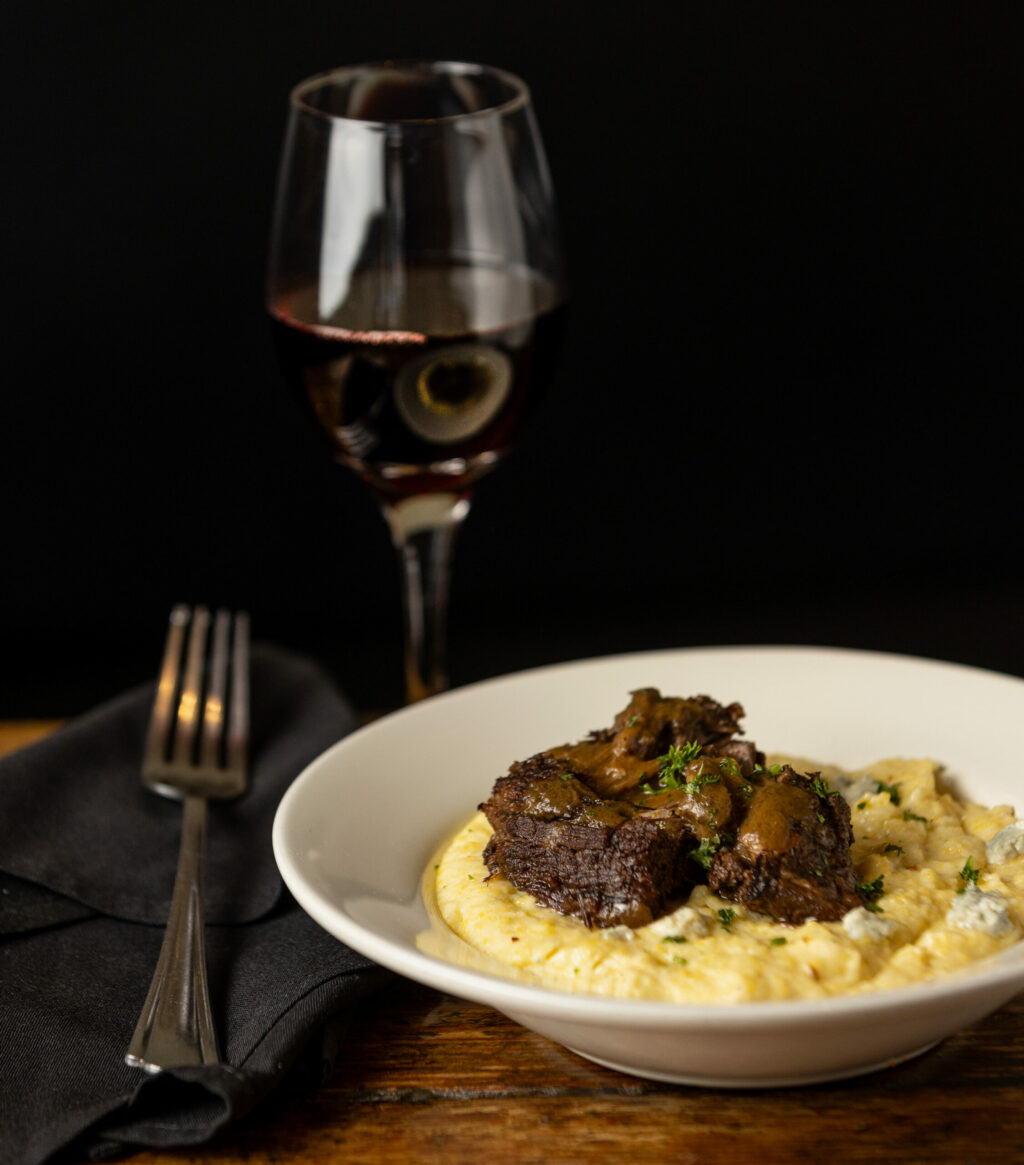
Braised Short Ribs with Blue Cheese Polenta, $24: I’ve had braised short ribs from some of the best chefs in Sonoma County, and these were — by a landslide — my favorite. Long-braised meat that’s not too fatty or lean falls apart faster than a Temu sundress. The polenta instantly raised my mood and cholesterol level, held together with more dairy than a milking barn. The blue cheese is an accent rather than a statement. The leftovers were extraordinary.
Lobster Mac and Cheese, $18: Exactly what you wish mac and cheese would be, but usually isn’t. Fontina adds creaminess to the sauce, with bits of bacon hidden about. Bowl-shaped orecchiette pasta, is perfect for holding onto breadcrumbs and cheese. My only complaint — I’m not sure the lobster adds that much to the whole thing. It would be equally delish without it. Either way, outstanding.
Tapas: Whether you make these a starter or a meal, little shared plates of papas bravas ($9) and spicy cauliflower ($14) are my favorites. Papas bravas are fried fingerling potatoes sprinkled with chili powder and served with chipotle aioli — which is how any fries should be served. Cauliflower is only a stinky carrier for sauce, in my book. This version of pan-fried florets has prickles of Anaheim pepper and salty capers that make it a joy rather than a punishment.
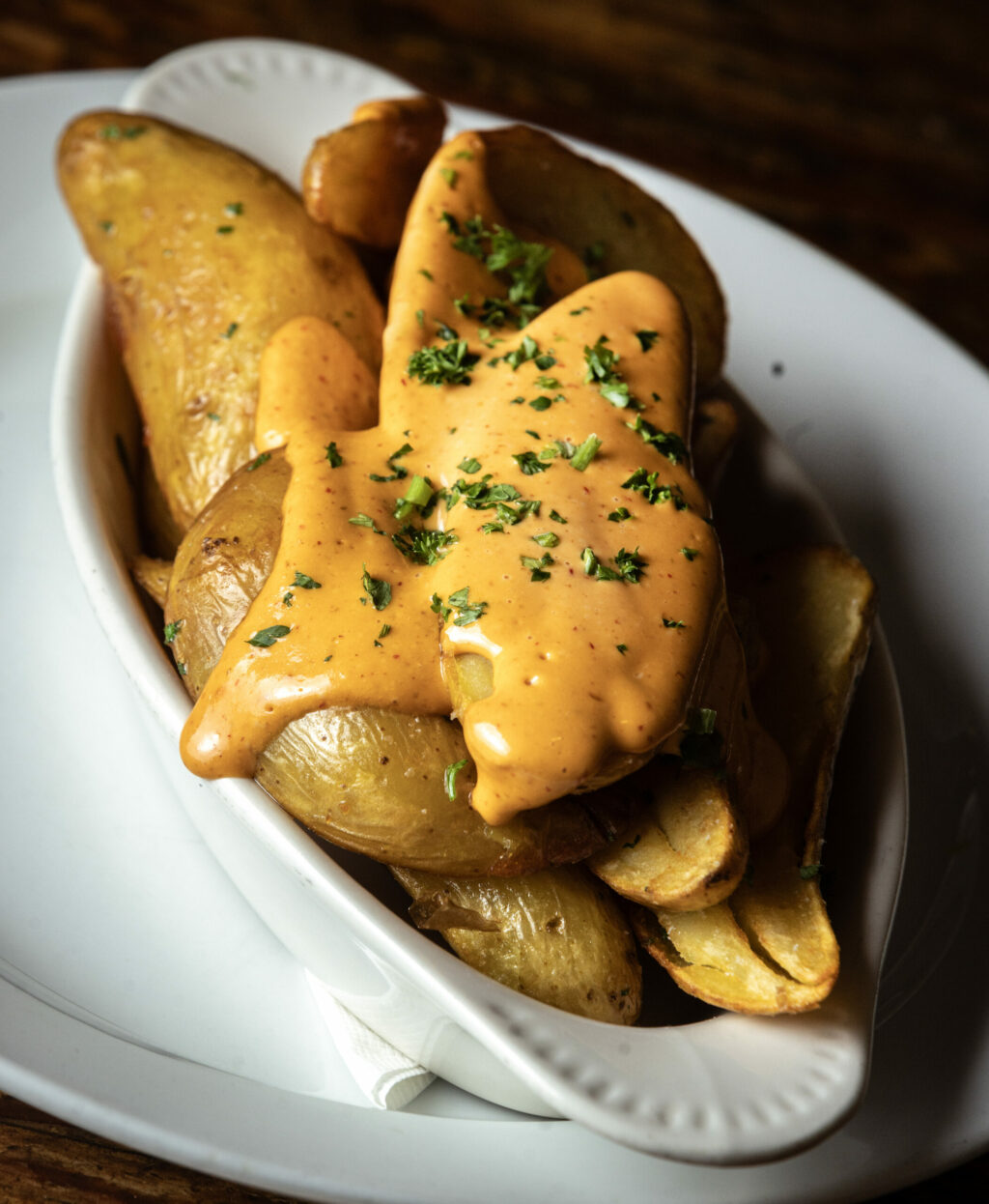
Tacos, $17 for three: Our favorite tacos were vegetarian and delicious. Soft corn tacos are piled with cabbage slaw, avocado puree and parsley, with a choice of meat or vegetables, but jackfruit smothered in sweet-sour barbecue sauce (a pulled pork dupe) and fried plantain with coconut were our top picks.
Fried Chicken, $23: If a TV dinner were delicious, this is what it would be. Crispy boneless chicken breasts, perfectly smooth mashed potatoes and flavorful gravy take me to a happy place sitting on the sofa, watching the Muppets and feeling like all is right with the world. If only there were a little square of overcooked apple pie.
Speakeasy Burger, $16: A simple, good burger served on a smushy brioche bun and all the fixings. Chipotle aioli gives it an added zing. Nothing complicated, nothing showy, just tasty.
Cheesecake, $7: Made in-house, flavors change with the chef’s whims. It’s more of a classic cheesecake that’s moist, fluffy and not overly sweet atop a buttery graham cracker crust. It’s not a mile-high Cheesecake Factory style, but a more modest grandma-style.
Speakeasy is open from 5 p.m. to 10 p.m. Monday through Thursday and until midnight on Friday and Saturday. Brunch begins at 10 a.m. Saturday and Sunday. 139 Petaluma Blvd. N., Petaluma. 707-776-4631, speakeasypetaluma.com
You can reach Dining Editor Heather Irwin at heather.irwin@pressdemocrat.com. Follow Heather on Instagram @biteclubeats.
The post Speakeasy Serves Late Night Comfort Food in Petaluma appeared first on Sonoma Magazine.
]]>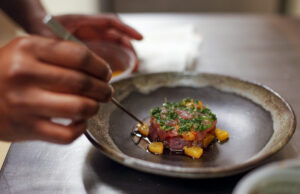
The French-inspired restaurant, Bijou, is slated to open in May at the former Easy Rider in downtown Petaluma.
The post Fine Dining Chefs From Table Culture Provisions Taking Over Easy Rider Space in Petaluma appeared first on Sonoma Magazine.
]]>





The owners of Table Culture Provisions (TCP) will open a new French-inspired restaurant, Bijou, at the former Easy Rider in downtown Petaluma after plans to take over the former Quinua Cocina Peruana (500 Petaluma Blvd. S.) stalled.
“It’s our little jewel,” said Table Culture Provisions executive chef and co-owner Stéphane Saint Louis of the contemporary California-French restaurant slated to open in May. Saint Louis will head the kitchen while business partners Marta Saint Louis and chef de cuisine Steven Vargas remain at Table Culture Provisions.
Easy Rider, a 60-seat restaurant in the heart of Petaluma’s restaurant and entertainment district, closed Dec. 31 amid speculation that a new owner was taking over the space. At the time, Easy Rider co-owner Jared Rogers said he was legally bound not to disclose details but hinted that a Sonoma County restaurateur might take over the location.
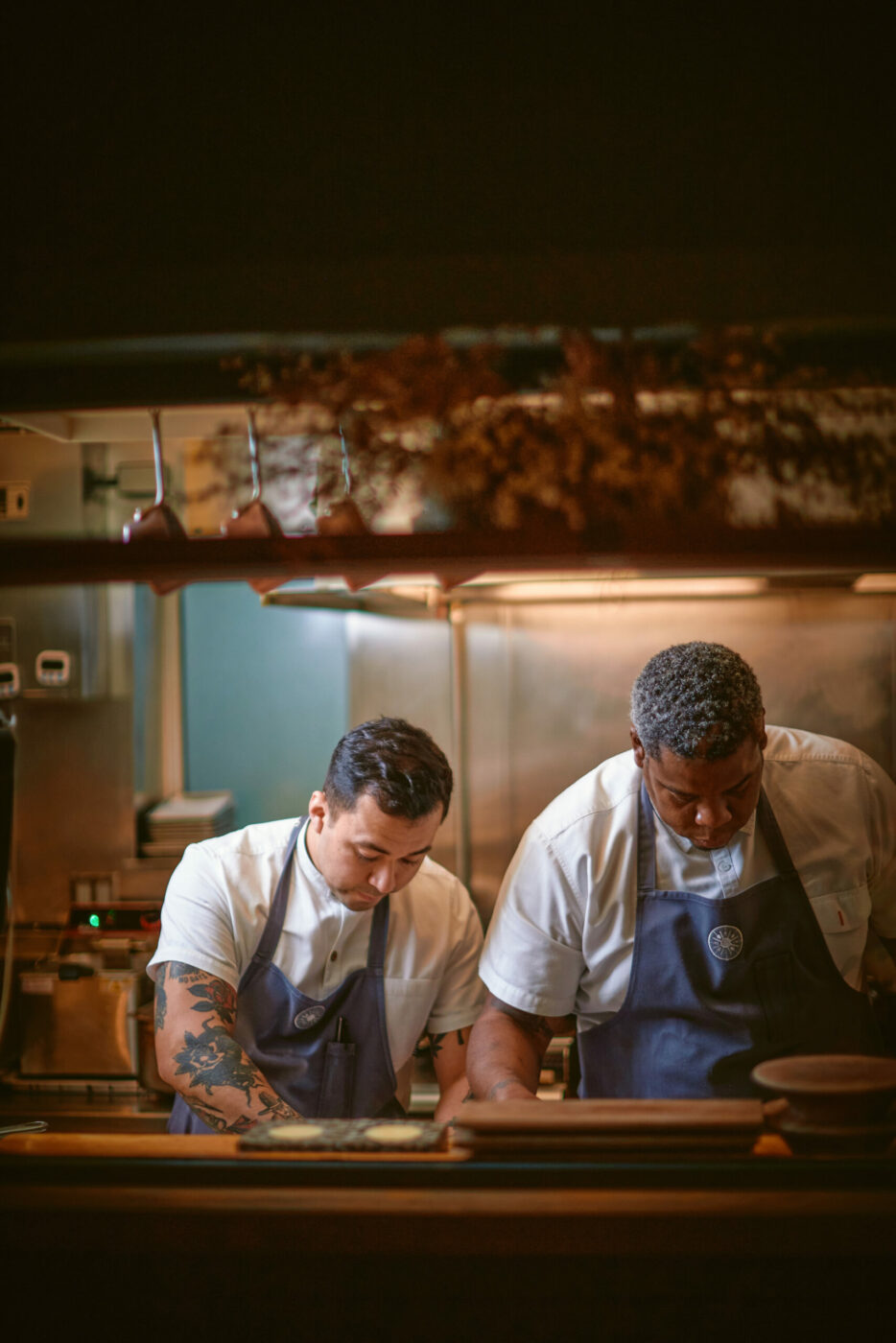
While Table Culture Provision’s tiny 10-table restaurant at 312 Petaluma Blvd. S. will continue its focus on multicourse fine dining, Bijou will offer a more casual experience Saint Louis likens to TCP’s social hour menu.
Offered from 4-6 p.m. Wednesday and Thursday, the paired down à la carte social hour menu includes larger entrées like a Della Fattoria rosemary boule stuffed with Red Hawk cheese from Cowgirl Creamery, Flannery Steak & Frites with a black peppercorn sauce or daily fresh made pasta, most under $40. The seven-course tasting menu at TCP is $135 per person.
“Bijou is Social Hour on steroids,” said Saint Louis.
Though the menu is still in development, Saint Louis offered up Beef Wellington, seasonal stuffed Caramelle pasta or colossal Prawns à la Provençale and desserts from TCP executive pastry chef Sylvain Parsy, including opera cake and rum baba, as potential dishes.
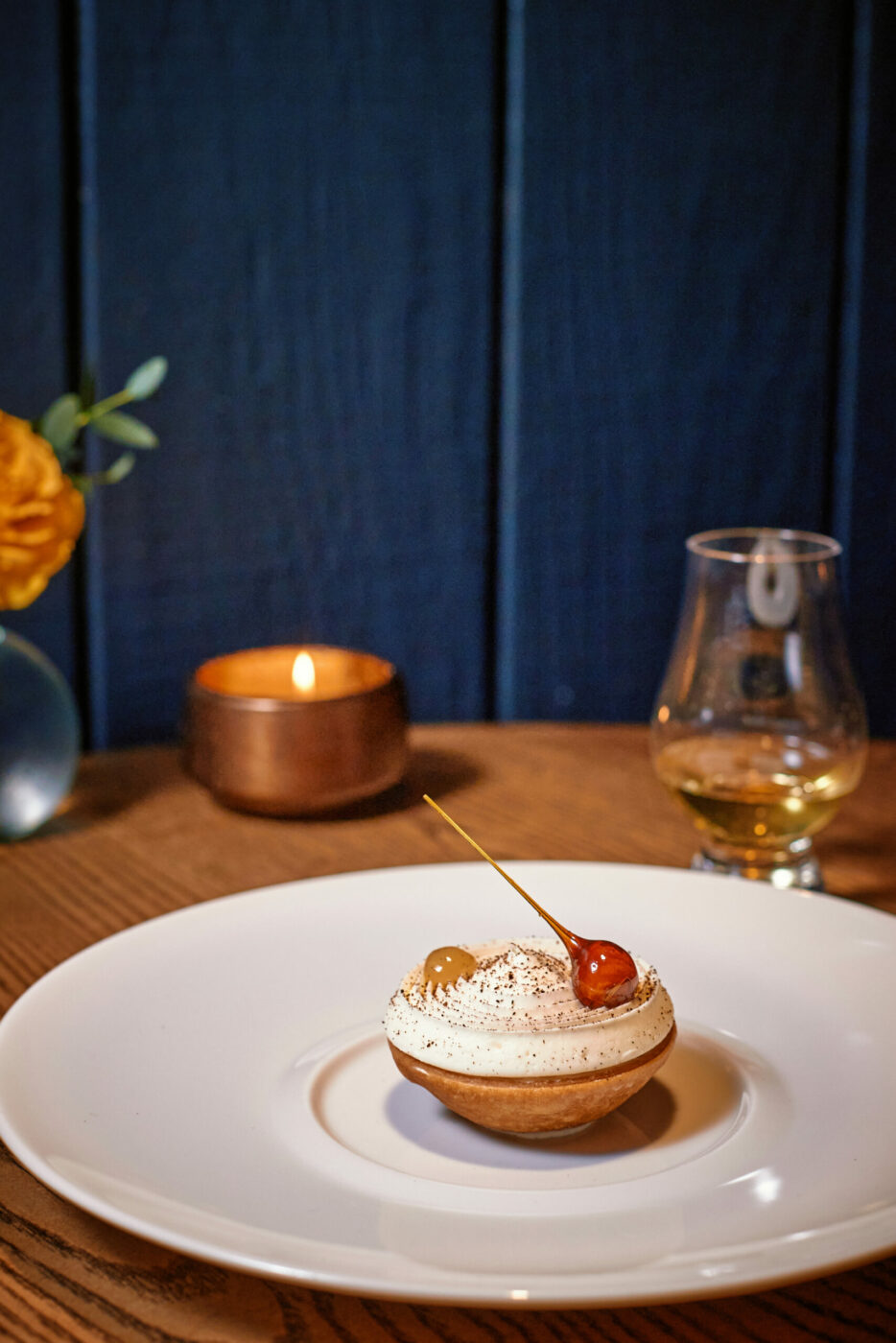
“It’s French technique creating a Sonoma County farm-to-table, seasonal dining,” said Saint Louis. The restaurant will also offer brunch and coffee and pastries on weekends, he said.
While Sonoma County has seen a renaissance of French cuisine, with the openings of nearby Brigitte Bistro, Augie’s in Santa Rosa and Maison Porcella in Windsor, Saint Louis is clear that Bijou isn’t a bistro but “Bistronomy” — serving approachable dishes with high-end cooking techniques.
Saint Louis said the 60-seat Bijou will also have cocktail and wine programs and some late-night hours on the weekend.
Stay tuned for more details.
You can reach Dining Editor Heather Irwin at heather.irwin@pressdemocrat.com. Follow Heather on Instagram @biteclubeats.
The post Fine Dining Chefs From Table Culture Provisions Taking Over Easy Rider Space in Petaluma appeared first on Sonoma Magazine.
]]>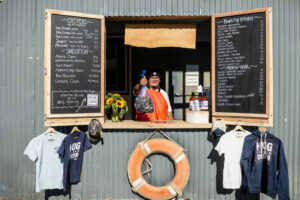
Find oysters, shellfish and other local catches at Hog Island Oyster Company's new Petaluma pickup window.
The post Renowned Oyster Company Opens Petaluma Pickup Window appeared first on Sonoma Magazine.
]]>





Hog Island Oyster Co., a popular seafood establishment on the Sonoma-Marin Coast, has opened a Petaluma pickup window on First Street. The menu features oysters, shellfish (clams, mussels, prawns) and other local catches, including squid, abalone and geoduck clams.
Customers will also be able to pick up kitchen staples, including Hogwash mignonette, cocktail sauce and miso nori butter, as well as Hog Island merch.
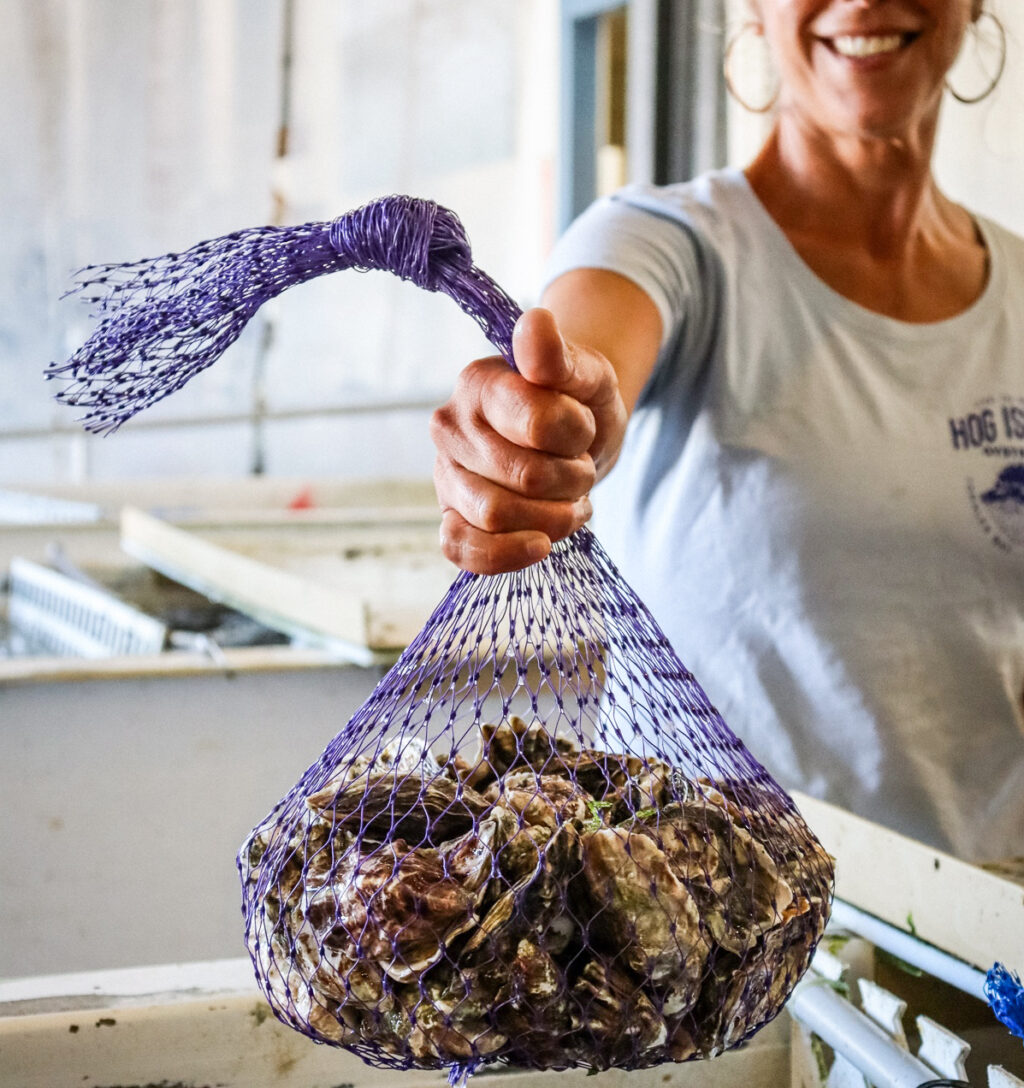
Orders must be placed online or over the phone for pickup from 9 a.m. to 1 p.m. on weekdays.
419 First St., Suite B, Petaluma, 415-390-4219, hogislandoysters.com
You can reach Dining Editor Heather Irwin at heather.irwin@pressdemocrat.com. Follow Heather on Instagram @biteclubeats.
The post Renowned Oyster Company Opens Petaluma Pickup Window appeared first on Sonoma Magazine.
]]>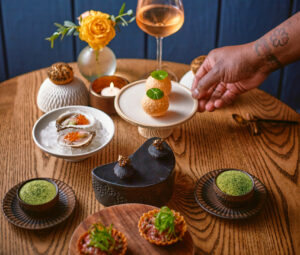
Peek behind the counter at Table Culture Provisions, where collaboration and a can-do optimism underlies a top-level menu filled with Sonoma flavor.
The post Table Culture Provisions: A Fine-Dining Success Story in Petaluma appeared first on Sonoma Magazine.
]]>





On a recent night in Petaluma, inside a tiny restaurant on the outskirts of downtown, the first bites of a tasting menu arrive, each an elegant, flavorful surprise: Jet-black squid-ink madeleines topped with caviar and gold leaf, a delicate taste of the sea. Silky beef tartare in a crisply fried wonton shell. A frothy cup of asparagus cappuccino.
Here at Table Culture Provisions, the menu channels its owners’ talent and skill—but also their fundamental optimism. It’s a rough time to have a high-end restaurant. Rising costs and staff burnout plague the industry, and profit margins for fine dining are slim.
But Table Culture Provisions holds its own as part of a growing movement to pivot away from toxic perfectionism, 16-hour workdays, and costs soaring out of control. Chefs and business partners Stéphane Saint Louis and Steven Vargas have learned how to serve fine dining’s most rarified form—the tasting menu—while keeping their sanity intact, their budgets lean, and their hearts warm and generous.

The Launch of a Dream
Vargas and Saint Louis have been scrappy from the start. Stéphane Saint Louis, a tall, confident man with a kind yet intense gaze, grew up in Haiti, where food and family set the weekend rhythm.
“On Saturday mornings, the puff pastry vendor would drop half a dozen at our door,” he remembers. “Sunday was all about church and stopping at friends’ houses for dinner.”
Saint Louis moved to Marin County at 17. When he got interested in cooking, one of his aunts cosigned the loan for culinary school at the California Culinary Academy in San Francisco. Later, another aunt paid his way at the renowned Institut Paul Bocuse in Lyon, France. (“Aunties are clutch,” he says.) After internships, Saint Louis returned to California in 2017 to lead a new dinner program at Petaluma’s Della Fattoria, where he met his future business partner.
Steven Vargas, born and raised in Petaluma, was a chubby-cheeked, soft-spoken apprentice fresh out of culinary school at Santa Rosa Junior College. As a kid, he’d spent summers with his grandmother in Acapulco.
“I’d catch the chickens in her backyard and she’d slingshot iguanas for tacos, my favorite,” says Vargas. “She’d have the entire family, 20-plus people, for dinner on the weekends.”
At Della Fattoria, Vargas was on fire, Saint Louis says. “Apprentice? There was no apprentice. He was picking up most of the work, and he excelled at it. For any task, you knew you could depend on him.” Plus, Vargas had an excellent, semi-ironic tattoo on his right arm: the Grim Reaper clutching a cup of coffee above the words “No Days Off.”
Vargas, for his part, was inspired by Saint Louis. “The furthest east I’d been was Texas. I was captivated by his experience.”
Saint Louis had a tattoo of his own, a Michelin star, reminding him always of the standards he held high. In March 2020, as the world turned upside down, the friends found themselves at a turning point.
“Pandemic or no pandemic, as long as people exist, they gotta eat,” says Saint Louis. “We said, we can go home and collect unemployment, or we can take advantage of the situation and make people feel better in these hard times by offering a good meal.”
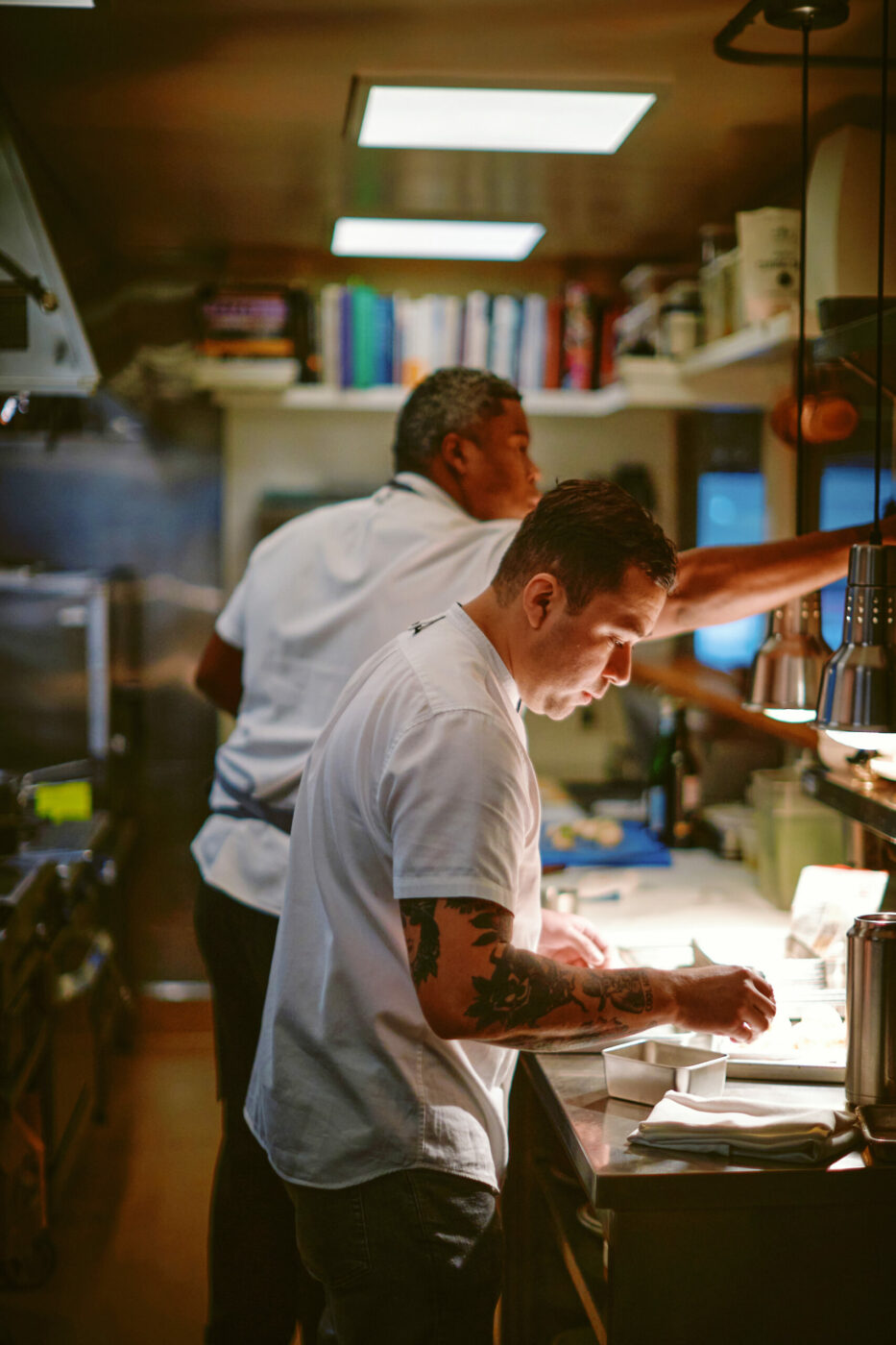
They started a fried-chicken takeout pop-up at The Shuckery. Then, in a now-legendary move, the two invested their pandemic-era federal stimulus checks, totaling $2,700, in Tesla stock. Within a few months, the investment was worth $17,000—enough for a down payment on a catering truck.
They used the revenue from selling fried chicken to stay afloat, later moving to a semipermanent home in Petaluma at Wishbone restaurant. Along with the move came a new name: Table Culture Provisions—a nod to their diverse backgrounds, and one that seemed broad enough to hold space for all their ideas, including, someday they hoped, their own restaurant.
Table Culture Provisions took off, going from one night a week to two, with brunch on the weekends. Saint Louis and Vargas served global comfort food like cassoulet, trout en croute, even a multicourse Haitian feast featuring braised oxtail and rum cake with proceeds going to help fund a school in Haiti.
After securing additional financing from a local supporter, they were ready to look for a permanent home. The spot they settled on seemed improbable at first—a former chili joint with only seven tables— but the kitchen was functional, and the price was right: $150,000.
“We were so desperate, and we were so into it,” remembers Saint Louis. “We decided to make it work.”
Down to their last $1,000, they needed to open the restaurant as soon as possible. They had the walls painted a deep slate blue, enclosed the kitchen, and added a long window into the dining room. Two weeks later, in December 2021, they launched.
Right away, they were doing 40 to 50 covers a night, with an à la carte menu and brunch on Sundays—and almost right away, they realized their concept was losing money. With checks topping out at about $60 a person and room for so few customers, they couldn’t cover costs.
“Our bookkeeper told us we wouldn’t last another couple of months,” says Saint Louis. “But in a way, we’re richer when we’re more broke. It forces us to innovate.”
So he and Vargas and their newly hired team, working “like a bunch of madmen,” introduced a higher-priced tasting menu alongside the à la carte one, and found that customers preferred it. They tinkered with various tasting menu lengths and prices to find out which would resonate most, sometimes cranking out three or four menus at once—which made service “complicated,” to put it mildly.
Two and a half years later, they’ve dialed in the options. The à la carte menu has morphed into a “Social Hour” twice a week. They’ve got a side hustle supplying breakfast pastries and sandwiches for a nearby coffee shop. They’re offering four-course and seven-course tasting menus four nights a week, trimming a crew of 11 cooks and servers to seven. And they have a sommelier, Robert London, a wine importer, early customer, and immediate fan.
“We’ve been like starving artists,” says Saint Louis, laughing. “We’re by no means in a comfortable spot, but at the same time, we’re always aiming for more.”
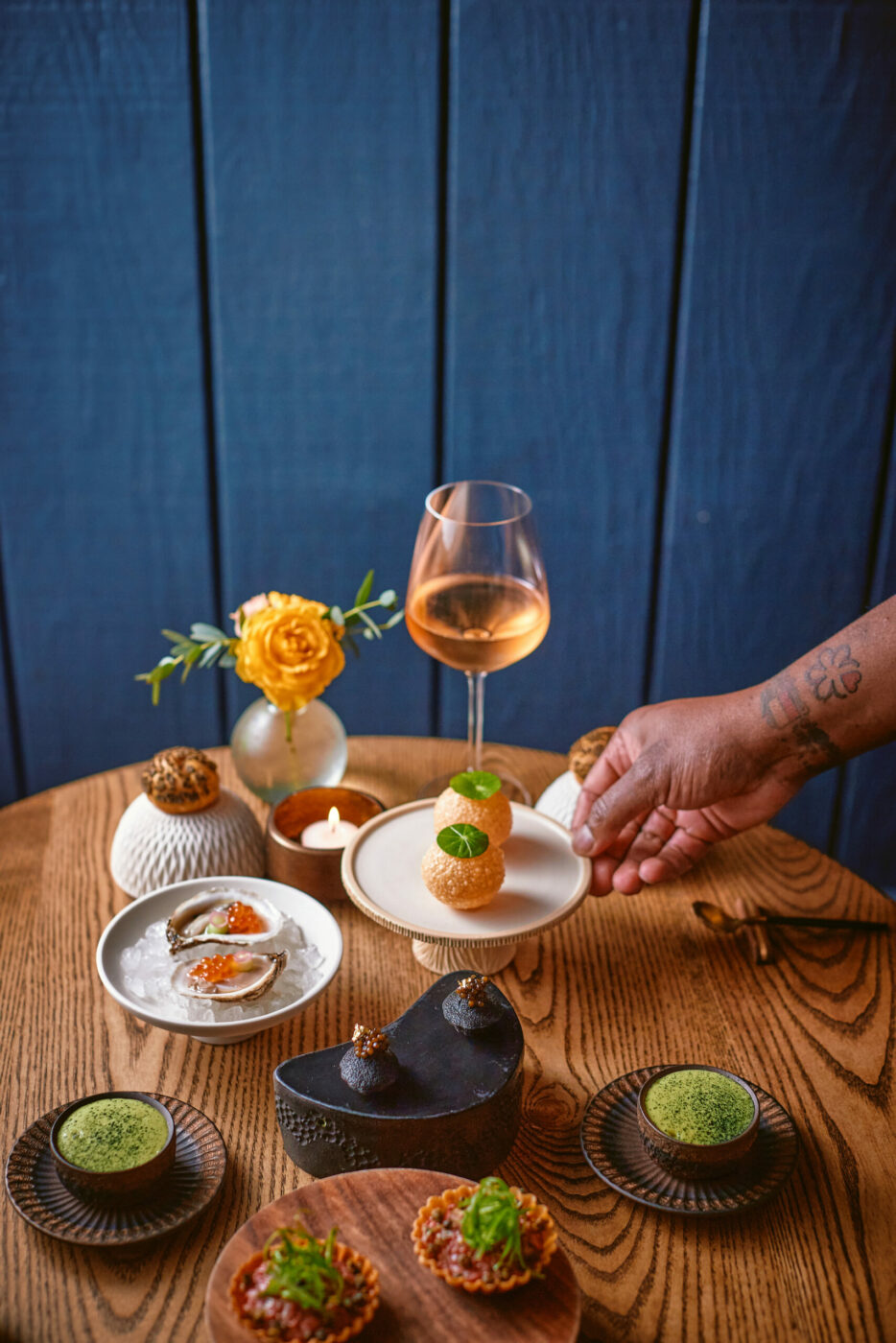
What It Takes
Table Culture Provisions is a story of ambitious food on the leanest of budgets, and of building camaraderie and community. While shows and movies like “The Bear” and “Boiling Point” give the picture of fine-dining kitchens as near-intolerable pressure cookers, with chefs melting down under the strain, the mood in the tiny kitchen remains measured and respectful.
The workspace is just 400 square feet, packed neatly with countertops, sinks, a stovetop, and ovens. To pass someone in the narrow central walkway, you have to turn sideways. There are only three chefs for dinner service—Saint Louis on the hot station, Vargas expediting tickets and assembling plates, and French pastry chef Sylvain Parsy.
Although each chef has a focus for the night, everyone helps out with everything—and Saint Louis and Vargas will sometimes swap places for the night, just for fun. Each does all his own prep, saving the cost of a traditional kitchen brigade with its specialized roles. They wash their own prep dishes and scrub down the kitchen at the end of service as a team.
“We never have a problem with that,” says Saint Louis, swiftly cutting steak into tiny dice for the beef tartare. “That mentality helps us keep a healthy workplace. We don’t expect the lowest guy to do it. We’ll get down and get things done, together.”
All the cooking is driven by what’s in season locally. Much of their produce comes from Asombrosa, a farm on 63 lush, hilly acres outside town.
“We change the menu every six to eight weeks,” says Saint Louis. “Our farmer sends us updates, and we plan around availability. How many pounds of peas are there, and how long will we have them? Then: How do we treat the peas—do we blanch and pair them with halibut, or do a cold pea shooter with mint oil? Are there pea flowers, for garnish?”
Together, the three chefs start charting the new menu, bouncing ideas around as they’re cooking. “We set our hearts on the techniques, and then we go for it,” says Saint Louis. “Then, once the menu starts, the ideas become more clear. By the second week, we’re mastering it, finding ways to streamline or amplify, hitting the sweet spot.”
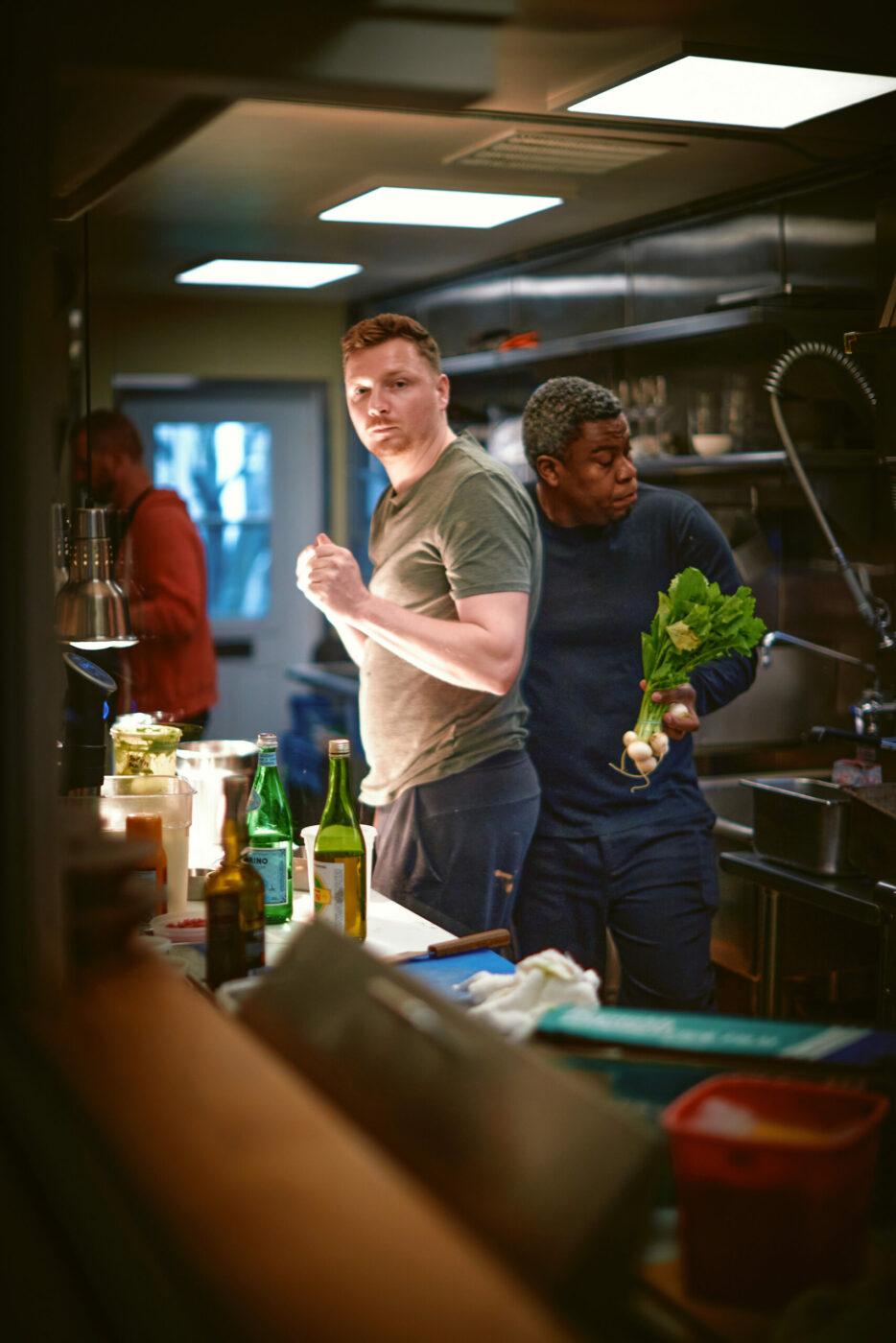
Every bit of food gets used. Spring asparagus, for example: Saint Louis sears the dark-green tips to pair with black cod. The ends go into the asparagus cappuccino and the arancini, or fried rice balls. Beef trim, left from braising beef cheeks for ravioli, becomes the base of the velvety sauce on that pasta.
These chefs prep their food as if they were jewelers, crafting each exquisite component with care. Saint Louis drapes a gougère with a wafer-thin circlet of buttery, salty-sweet nori seaweed dough, then slides a panful of the savory puffs into the oven.
“The weight of the flour and butter keeps the gougère’s shape intact,” he explains. “It also gives the pastry a crackly, crisp texture.”
Creating a leek garnish takes no less than seven steps. Vargas slivers fresh leeks, blanches them in boiling water, plunges them in ice water to set the color, and dries them out in a dehydrator. “No coating. We want them to stay very green.”
Using chopsticks, he culls any thick, ungraceful strands. Then he fries the leek threads, agitating them constantly to prevent clumping or browning. He fries them a second time, to get them ultra-crisp. Finally, the leeks become glistening, crunchy tumbleweeds of flavor, ready for the fish course.
The chefs are always looking for ways to improve techniques, make them more efficient. Instead of individually baking the wonton pastry shells with pie weights in the classic manner, they just stack the raw wontons in their fluted metal tins and deep-fry the entire stack at once. The wontons emerge perfectly pleated, crisp and golden.
“Paul Bocuse is probably turning in his grave right now,” says Saint Louis. “But the point is the end result, and this works better.”

A Record Player in the Kitchen
At the pastry station, tucked into the far corner, Sylvain Parsy sets a pear and milk-chocolate tartlet on a turntable—an actual 45 rpm record player he bought for the purpose—and gets it spinning. Bending in close, hands steady, he pipes on Chantilly cream, wrapping the top of the tart in a perfect ivory spiral.
“I had to do 50 of these before I got the hang of it,” he admits. For the final touch, he dips a skewered hazelnut into molten sugar, and then suspends it from a shelf until the dripping caramel forms a delicate candy spear: “One of our waiters calls this the Hazelnut Meteor.”
Any of the restaurant’s tasting menus has dozens and dozens of these components, requiring fierce attention and skill. “Our small scale saves us,” Vargas says. “If we were larger, the labor and time would cost us too much.”
Despite the intensity of the work, the mood isn’t somber. There’s plenty of joking and teasing going on, especially around the fantasy basketball league they’ve started.
“I saw your trades last night, late,” Saint Louis says to Parsy. “Why weren’t you sleeping? You’re not panicking, are you?”
Family stops by, too. Marta, Saint Louis’s wife and the restaurant’s bookkeeper, often pops in with one of their two young children in tow. Not surprisingly for a chef’s kid, Saint Louis’s 6-year-old will taste anything—and deliver a thumbs-up or a thumbs-down.
Those visits help Saint Louis maintain balance in his life. Living close to work—he and Vargas both have houses just down the block—helps too, saving commuting time. They both take Sundays off, Saint Louis for family outings, Vargas to explore local restaurants and wineries.
“Sometimes I’ll sneak into the restaurant and just be here alone, to collect my thoughts,” says Vargas.
“For me, it’s a lifestyle,” says Saint Louis. “I enjoy this. I never wake up and think, ‘Oh, I have to go to work.’”
On the days the restaurant is open, the chefs arrive by 11, ready to crank. Well before service starts at 5 p.m., each chef has his components and garnishes finished and backup food stowed in undercounter fridges.
Yulia Quintas, a dishwasher so fast Saint Louis calls her “the little machine,” arrives and starts darting through the kitchen, restocking dishes, running to the back storeroom, doing whatever anyone needs. She’s a pure burst of joy, smiling and saying hello, even though she’s come straight from another restaurant job to make ends meet.
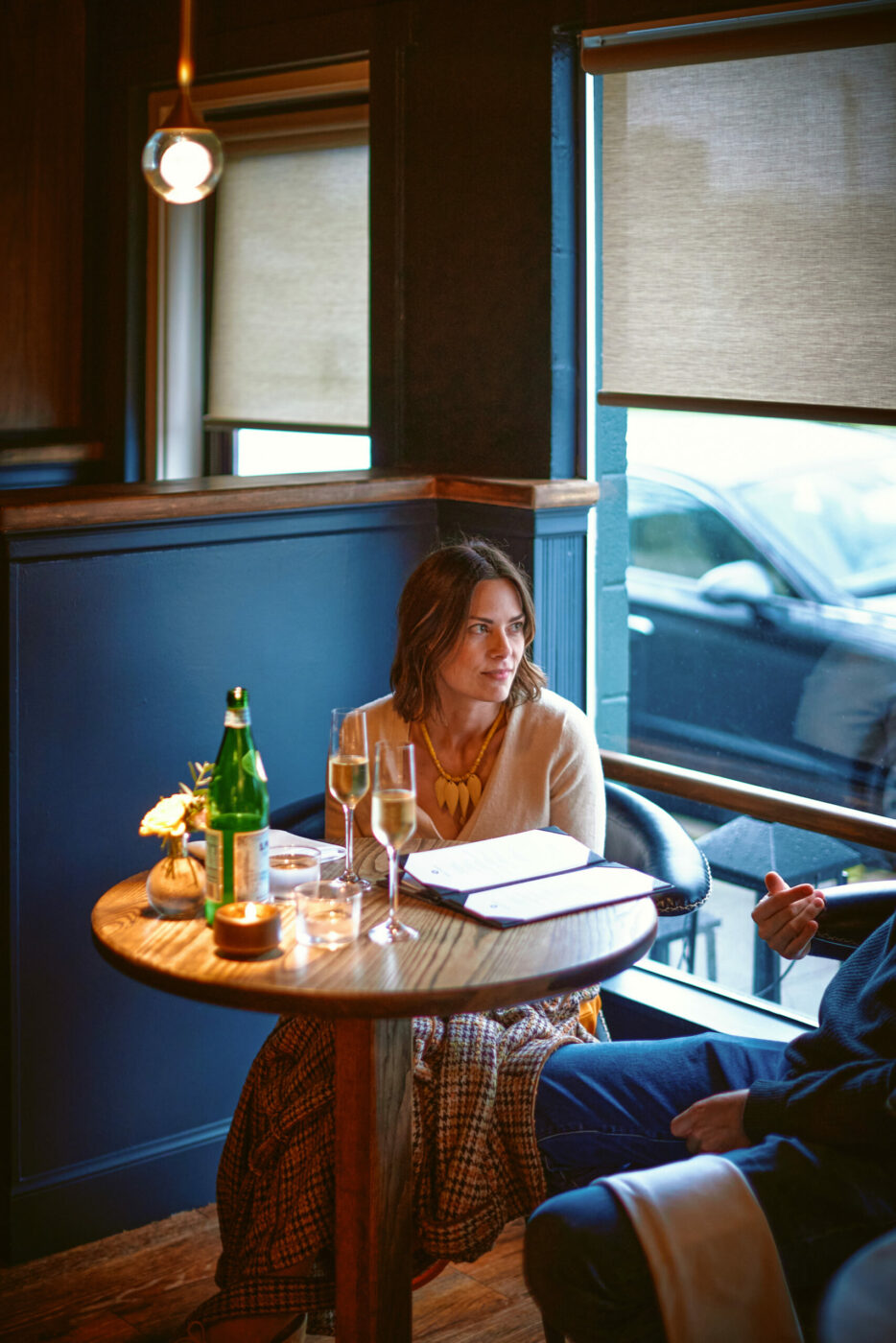
Time for Service
So much of Table Culture’s food must be completed to order, or its appeal will fade. Pastry shells must be filled, tiny flowers tweezed on, sauces drizzled, and powders sprinkled, cleverly, from a tea ball. That makes time management even more crucial than in a typical restaurant.
Vargas works the tickets, noting when each course is set in motion, but the trio of chefs rely on the servers to track the pace of each table. “The kitchen window lets us see the tables for ourselves, too,” says Vargas.
There’s only one timer in the kitchen, and that’s for fresh pasta: two minutes exactly. The rest of the hot dishes—fried scallops, the steamed fish, and the sauces, finished with butter and cream—all rely on Saint Louis and his internal clock.
As the orders swell, everything starts to speed up, turning the kitchen into a river of motion. Miraculously, no one collides, and it’s almost totally silent.
“We don’t need to talk,” says Saint Louis. “We all know the stations, and we anticipate each other’s needs.”
Parsy whips down the line to help Vargas with the crab salad bites, stuffing the shreds into crisp Indian-style puris. Saint Louis whirls between counter and stove, flinging butter into pots of sauce, blanching turnips, searing asparagus on the flattop, swirling ravioli into its sauce. The hot steel doors of oven and dishwasher flap down, up, down, timed to the movements of the cooks. Meanwhile, the three servers whip in and out, dropping dirty dishes, picking up orders, drying freshly washed silverware. It’s hectic, but not crazy. No one yells.
What Saint Louis appreciates most is being part of this Sonoma community. “We send out respect and thoughtfulness, and they’ve supported us all along, bringing new customers to us, too,” he says.
Vargas agrees. “We’ve heard that our restaurant is a great first step for a lot of people who’ve never experienced fine dining before. They’ll say, ‘It’s so warm here. Now I can go other places and know it won’t be intimidating.’”
The two dream big, with future plans bubbling on the burners. If all goes well, they’ll be opening another restaurant this fall—and judging from how their food has been received so far, chances are good their fans will show up hungry.
Near the end of the night, a customer comes into the kitchen. She’s been celebrating her birthday tonight, and her face is glowing. “To be a Petaluman and have this food,” she says, putting her hand on her heart. “I’m so proud.”
Table Culture Provisions, 312 Petaluma Blvd. S., Petaluma, 707-559-5739, tcprovision.com
The post Table Culture Provisions: A Fine-Dining Success Story in Petaluma appeared first on Sonoma Magazine.
]]>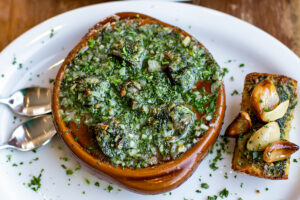
Chef Nick Ronan’s truly authentic French bistro is a much-appreciated addition to Sonoma County's food scene.
The post Petaluma’s Brigitte Bistro Is the Real French Deal appeared first on Sonoma Magazine.
]]>





In a nutshell: Chef/owner Nick Ronan serves the kind of food he loves best: hearty bistro-style dishes like beef bourguignon and duck confit, along with tableside beef tartare and the requisite steak frites. But instead of pandering to us, he brings the flavors of French homeland directly to the table. Ronan’s favorite motto, “Love. Food. Wine. Passion. Life. People” comes through in his comforting, homey cuisine.
For a long time, I’d given up on fancy French restaurants that boasted culinary superiority while kitchen staff worked the can opener on asparagus and veal demi-glace.
In the darkened dining rooms, dusty 1960s decor spoke of a long-gone age when men struck deals over hearty Burgundies, and women lunched over bottles of Chablis and salade vert. Thankfully, most of these scenarios have gone the way of the dinosaur.
But while classic French cuisine is at the heart of California’s cooking style — and most chefs cut their teeth making the mother sauces like béchamel and veloute — Sonoma County has only recently begun consistently embracing the authentic bistro-style and home cooking of France.
That’s why we’re saying a hearty, “Bonjour!,” to the new Brigitte Bistro in Petaluma.
Chef/owner Nick Ronan, who grew up between Paris and the south of France, is a guy who knows his French cuisine.
He’s worked in high-end European restaurants and co-founded several San Francisco restaurants, including the Pawn Shop, a now-shuttered dining experience requiring guests to enter through a faux pawn shop.
At Brigitte Bistro, he serves the kind of food he loves best: hearty bistro-style dishes like beef bourguignon and duck confit, along with tableside beef tartare and the requisite steak frites.
But instead of pandering to us, he brings the flavors of France directly to the table.
Ronan is a teddy bear of a guy with a propensity for enthusiastic hugging. His life motto (which everyone should have) is “Love. Food. Wine. Passion. Life. People,” which could come across as smarmy if he didn’t believe it wholeheartedly.
After going through several challenging years recently, including the death of his mother in 2023, he is even more dedicated to a life that embodies his personal tagline.
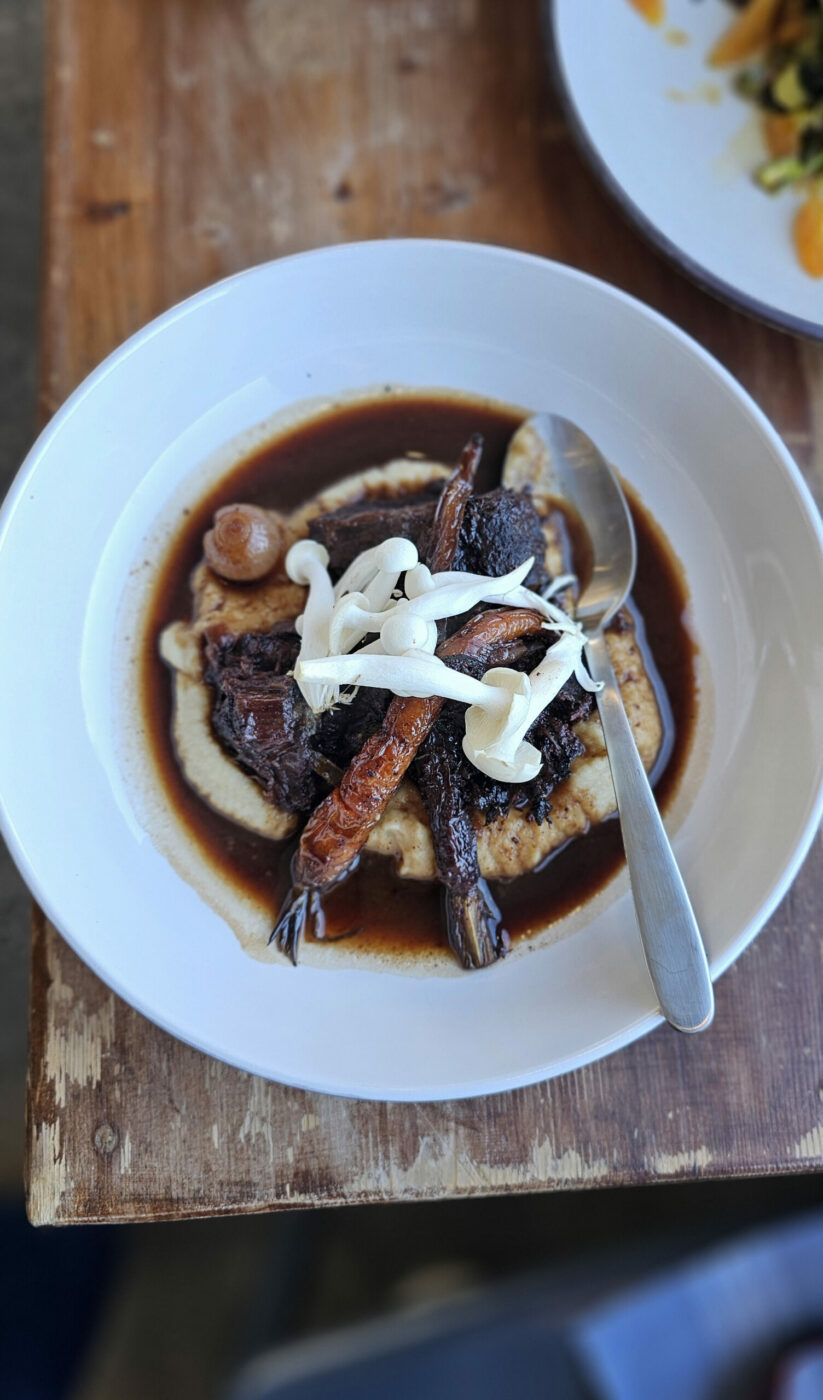
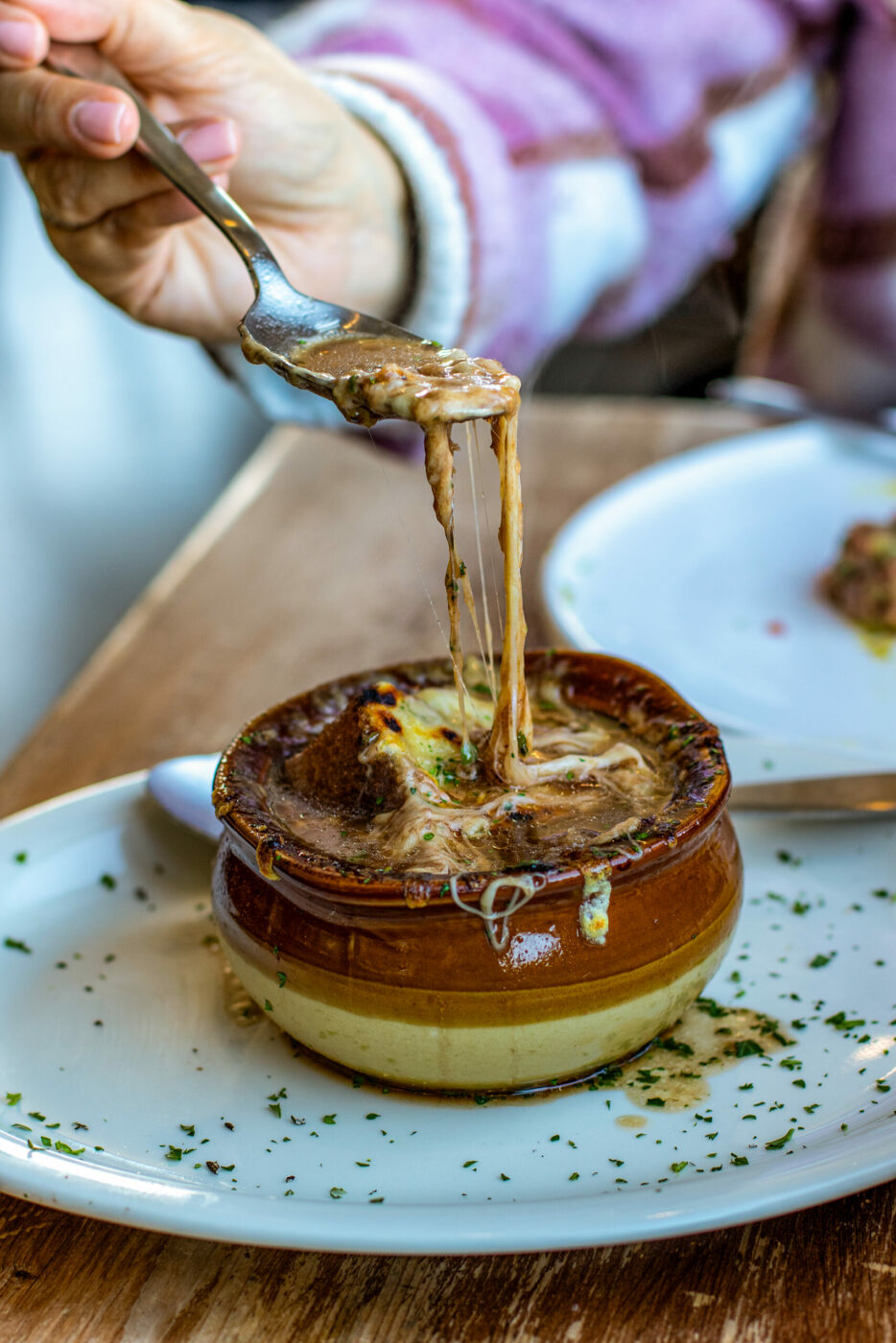
Housed in the former Wishbone and 3 Cooks Cafe space, which had become run down in recent years, Ronan gutted the interior and added walk-in bar seating, a chef’s counter overlooking the open kitchen, all new appliances and, somehow, a baby grand piano in the compact dining room.
After a few glasses of wine, Ronan said some piano-playing guests tickle the ivories with singalong favorites.
Wine is, naturally, a centerpiece of the menu. Most are approachably priced, with glasses mainly in the $12 to $18 range and bottles in the $32 to $80 range, though there are a handful over $200 if you’re feeling extravagant.
The wine list features Sonoma and Napa wines and well-selected French sippers that are excellent with food.
A few weeks after opening, service is on point, with several staff members coming from previous positions with Ronan. And, for patrons of the previous restaurants, the restroom is mercifully now inside. A minor detail, but funky, ice-cold potties accessed through the kitchen and down a claustrophobia-inducing alley always bugged me.
For Ronan, Brigitte Bistro isn’t a Michelin quest but a neighborhood gathering spot for a relaxed meal in the French tradition of feeding family and friends with love and passion.
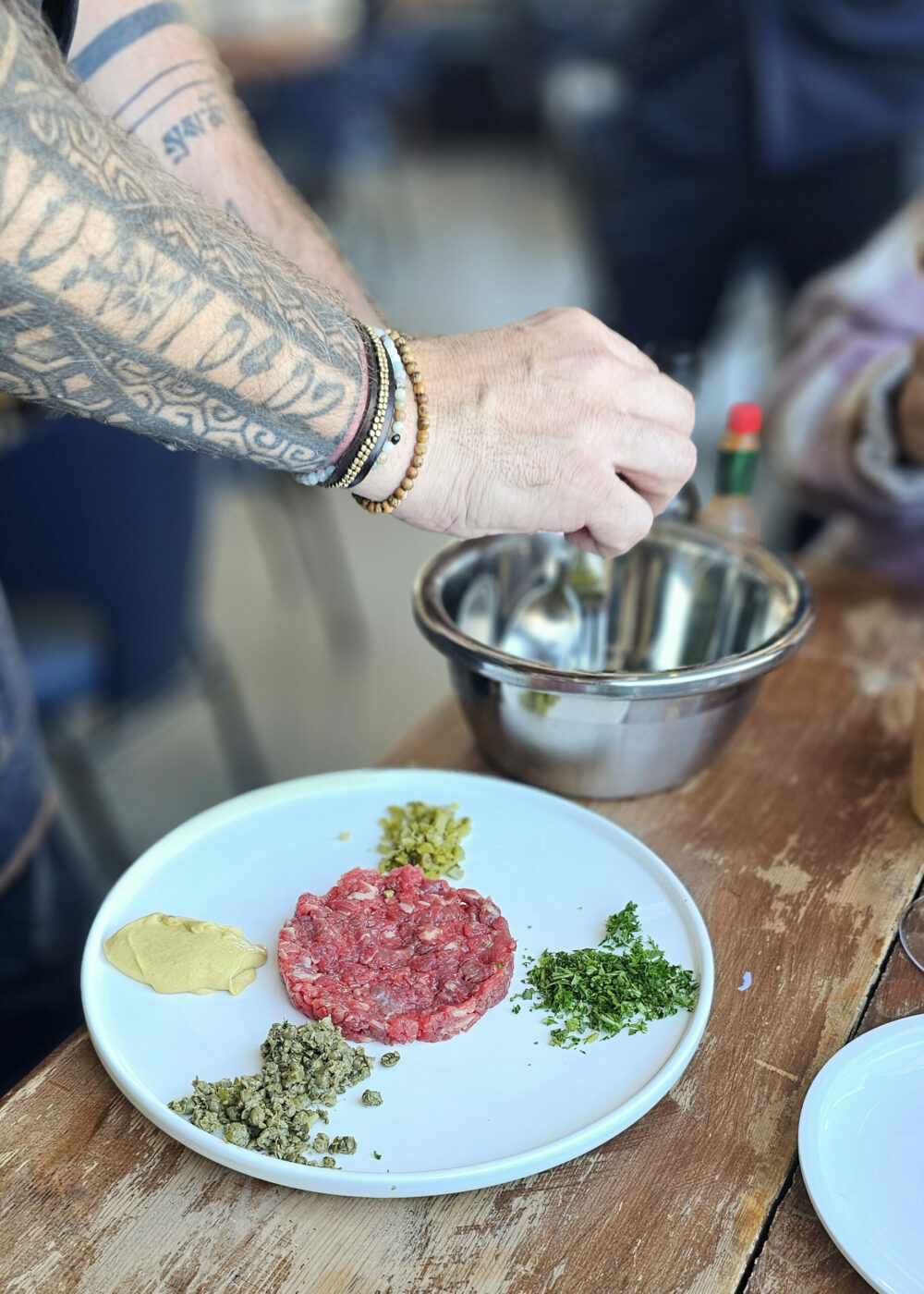
Best bets
Onion Soup Gratinée, $16: I’ve finally found the onion soup that’s eluded me for decades. Not too sweet, not too salty, but just right. The kitchen doesn’t overwhelm the bowl with too many onions, and they’re caramelized exactly right. The melted Gruyere pulls like Rapunzel’s hair.
Tableside Steak Tartare, $18: A plate of individual ingredients — raw chopped beef, mustard, cornichons, capers and Worcestershire sauce — arrives at the table and is quickly swept into a bowl to be mixed before your eyes. It’s both a show and an appetizer.
Grandma Escargots, $16: To be fair, most escargots come from a can, and that’s not a fault. Most French fries come from a bag. Slathered in garlic and butter, they’re darn tasty, but even better is side tartine — a thick slab of bread smothered in parsley garlic butter with garlic confit. You’ll want to sleep alone after eating them.
Beef Bourguignon, $34: This is required dining. Impressive cubes of braised beef in a red wine-port broth melt with the touch of a fork into buttery parsnip puree. I’ve had good, bad and horrifying versions of this classic dish (which only a French person should ever be allowed to cook), but rarely anything worth noting. Ronan’s is outstanding (the one at Augie’s French in Santa Rosa is also incredible), and finally have a benchmark to beat.
Duck Confit, $36: This dish features another tableside performance: a top hat of mixed mushrooms and leeks in truffle sauce poured over the crisp-skinned duck. It is served with potatoes mille-feuille, thinly sliced potatoes cooked lasagna-style in fat. Order some extra bread to sop up all the extra sauce.
Chocolate Fondant, $12: If you’re a chocolate lover, this lava-style cake is for you. Served with sea salt caramel ice cream.
Childhood Vanilla Flan, $12: The name doesn’t do justice to the slice of creamy but slightly firm flan dotted with vanilla beans. Simple and not overly heavy with a perfect scoop of raspberry (on my visit) ice cream.
If you go
What: Brigitte Bistro
Why: Truly authentic French bistro fare made with love and passion is a much-appreciated addition to Sonoma County’s food scene.
Where: 841 Petaluma Blvd. North, Petaluma
Information: 707-981-8381; brigittebistropetaluma.com
Hours: Open for dinner. Brunch coming soon.
The post Petaluma’s Brigitte Bistro Is the Real French Deal appeared first on Sonoma Magazine.
]]>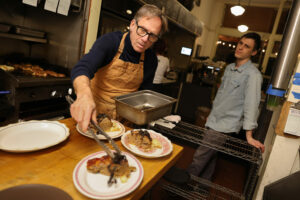
Chef Mark Malicki, who helped make the The Casino Bar & Grill in Bodega a dining destination, has created a new excellent pop-up experience in a 45-seat cafe and tea room.
The post Wild and Wonderful: de Havilland pop-up is a little bit of everything appeared first on Sonoma Magazine.
]]>





For nearly 13 years, chef Mark Malicki spent his Friday, Saturday and Sunday nights cooking in a closet-sized kitchen at The Casino Bar & Grill in Bodega. Inside that kitchen was a two-burner stove, flat-top grill and refrigerator drawer — not exactly a dream setup for a chef.
But somehow, Malicki made it work, serving up decidedly un-barlike dishes like short rib goulash with mushroom gratin, Dungeness crab from nearby Bodega Bay, buttermilk fried rabbit with rémoulade sauce or Wagyu with chanterelle mushrooms.
After years of owning restaurants or working for others, Malicki finally had the dream job of creating exactly what he wanted each weekend based on his relationships with local farmers and purveyors. Without the financial pressures of a brick-and-mortar, he thrived in the remote west county town as a culinary curiosity — an off-the-beaten-path food destination beloved by insiders but mostly ignored by the Michelin-star obsessed.
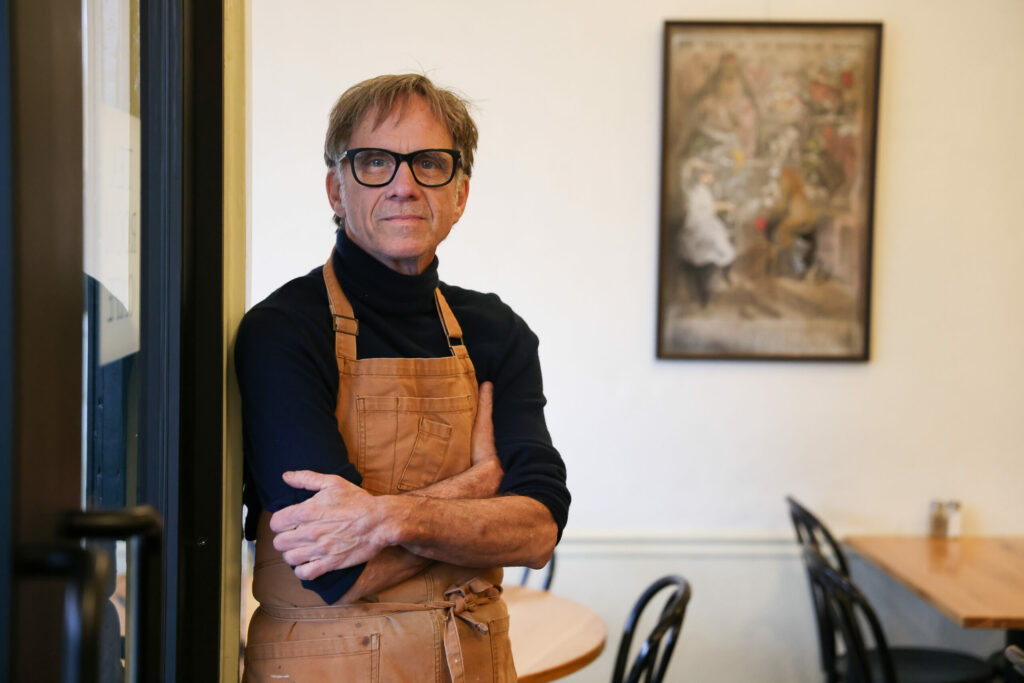
Now 64, Malicki says he was ready for a change, something closer to his Petaluma home and more expansive kitchen. Not that he didn’t love The Casino, its nonagenarian owner Evelyn Casini and its clientele, but after spending more than 50 years on the line and facing some health challenges, it was time for a more sustainable solution.
It was time for de Havilland.
Last summer, de Havilland — the name of his new pop-up dinner concept at the Tea Room Cafe in Petaluma — was born.
For several months, Malicki tried straddling weeknight dinners in Petaluma and weekends in Bodega but couldn’t find a balance between all the prep work and cooking.
In late 2023, he left The Casino and focused only on the 45-seat cafe and spreading out in the Tea Room’s large commercial kitchen. It turned out to be a perfect match.
De Havilland is a through line for Malicki’s deep-rooted passion for, well, whatever he’s passionate about at the moment — whether that’s frying latkes in Chinese scallion oil, feeding crab boat workers facing a deferred season, cooking for a fundraiser, or sharing a produce haul from his favorite farmer.
In the expansive kitchen of the Tea Room Cafe, Malicki juggles multiple pans and ovens with his sous chef, concentrating on the handful of dishes he has created for the evening.
A record player quietly pumps old jazz music into the room as guests casually order from the a la carte menu, and service is bare-bones but friendly and helpful. The wine list is short but well thought out, with small producers and unusual picks.
Recent dinners included Delicata squash boats with rice, crayfish and sea beans; stuffed mushrooms with wild boar sausage; cod with lobster broth; and caramelized Thai banana tiramisu.
What you’ll experience on the plate is usually a pleasant surprise unless you follow Malicki’s Instagram (@malle.mal), where he posts the evening’s dishes along with his frequent observations and insights.
There’s often a theme, but sometimes there isn’t, and it’s better not to go with any expectations. Just put yourselves into Malicki’s hands and enjoy being treated to the wild, wonderful, heartfelt, idealistic, perfectly imperfect world of de Havilland.
De Havilland is located at 316 Western Ave. in Petaluma. Dinner is offered from 5:30 to 9 p.m. Thursday through Saturday, with reservations recommended. Call 707-623-5141 or go to Instagram.com/malle.mal.
The post Wild and Wonderful: de Havilland pop-up is a little bit of everything appeared first on Sonoma Magazine.
]]>